Today's post highlights the recent work of photos in Peru. include members of the Ashaninka tribe; the Lord of Huanca Sanctuary; the "Ojo que Llora" memorial; blinding mists called "la garua"; and a memorial service for the Bishop Emeritus of Huancavelica.
Ashaninka Indian girls play soccer on Sept. 30 in Kitamaronkani, Pichari district, Peru. The Ashaninka Indian world has rarely been peaceful. PeruÃs Ashaninka Indians share the world's top coca-growing valley with drug traffickers, rebels, illegal loggers and, now, an increased military presence. During PeruÃs 1980-2000 internal conflict, Shining Path rebels overran their lands and slaughtered them wholesale.

Ashaninka Indian Antonia Ayeque stands outside her house on Oct. 1 in Kitamaronkani, Pichari district, Peru. The Ashaninka are the largest indigenous group in Peru's sparsely populated Amazon region but still account for less than 1 percent of the South American country's 30 million people. The people subsist largely on manioc, a diet they supplement with fish and wild rodents known as pacas.

An Ashaninka Indian woman cooks dinner next to her grandson in Otari Nativo, Pichari district, Peru. Otari, one of 350 Ashaninka communities, lies in the Apurimac river valley, the No. 1 coca-producing valley in the world. Despite the wealth-producing crop around them, OtariÃs nearly 150 residents live a largely pre-industrial existence. According to 2011 Health Ministry figures, nearly half the children suffer from malnutrition

Ashaninka Indian girls attend a public school on Oct. 1 in the Kinkibiri village, Pichari district, Peru. Ashaninka elders teach the new generations to appreciate the wilderness that sustained their ancestors, but many have given up on rainforest life and moved to cities. Elders also worry that their language, a member of the Arawak family, is disappearing. Area schools teach in Spanish.

An Ashaninka Indian woman washes a pot in a stream in Kitamaronkani, Pichari district, Peru. Peru's Ashaninka Indians share the world's top coca-growing valley with drug traffickers, rebels, illegal loggers and, now, an increased military presence. The government is now boosting its military footprint in the valley in a bid to fight Shining Path remnants and the drug traffickers they protect
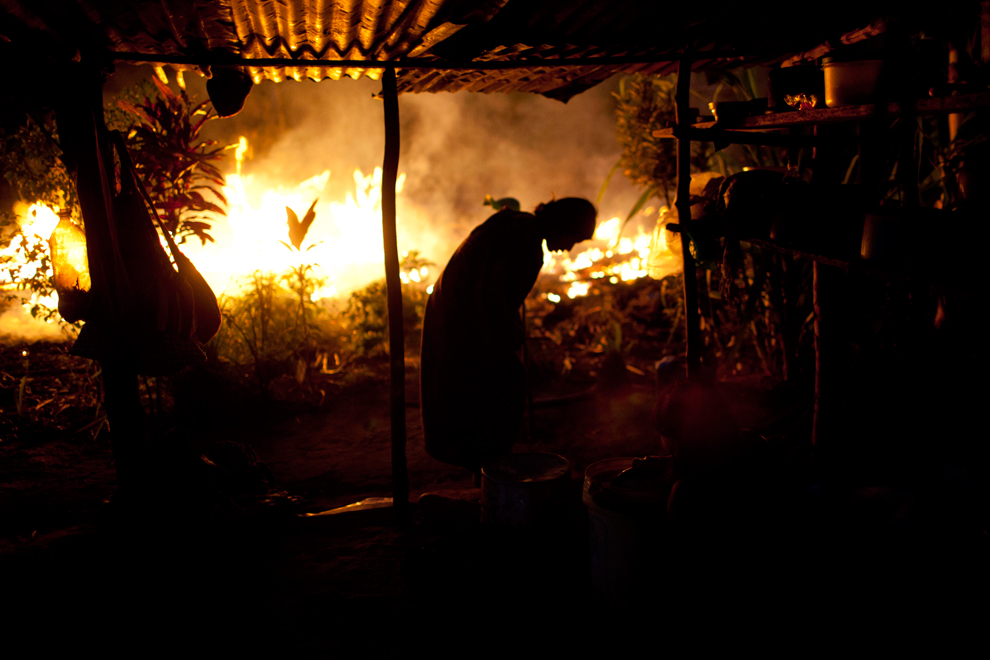
An Ashaninka Indian woman is silhouetted against a wall of flames caused by burning branches during a land clearing in Otari Nativo, Pichari district, Peru. Otari, one of 350 Ashaninka communities, lies in the Apurimac river valley, the No. 1 coca-producing valley in the world. Most inhabitants grow coca and chew it as their ancestors have. But they also resist efforts to fell their forests to plant coca for commercial use
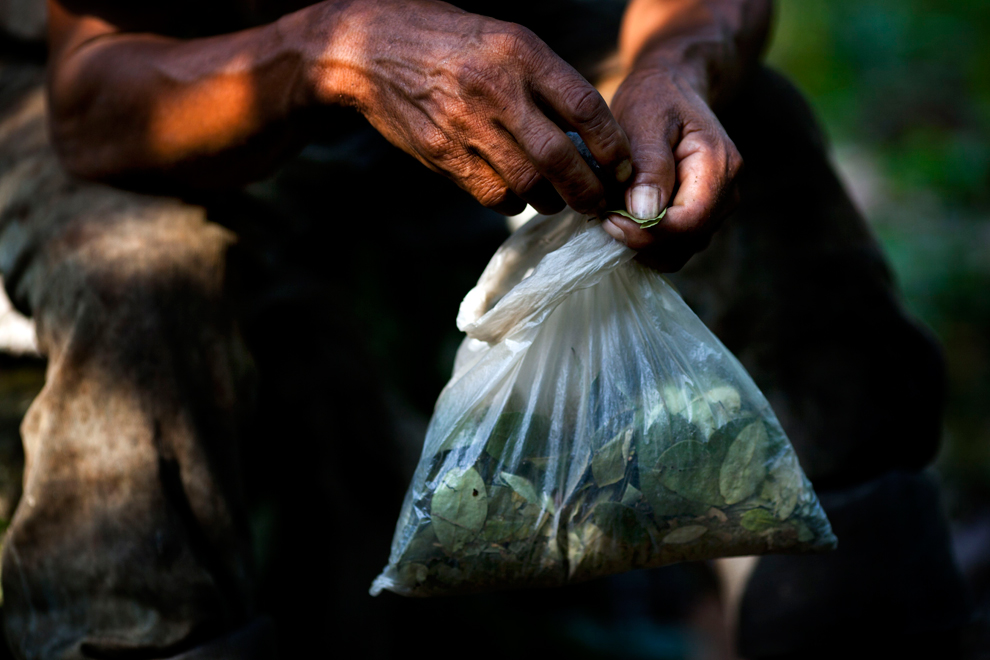
A field worker chews on a coca leaf, while taking a break from weeding in a cacao field in Ottari, a village in PeruÃs Pichari district on Sept. 30. For centuries, coca has been central to Andean culture and religious practices. But nowadays, the vast majority of PeruÃs coca supplies the illicit cocaine trade. The government encourages coca farmers to plant alternative crops such as cacao and coffee.

Sunlight filters through the clouds, illuminating the Apurimac river in Pichari, Peru. The river cuts through a long valley that the United Nations says yields 56 percent of Peru's coca leaves. The government says it will soon begin destroying coca crops in the region, known as the VRAE - the Valley of the Apurimac and Ene rivers

A girl plays in a bed of coca leaves on Sept. 25 in the village of Trincavini in PeruÃs Pichari district. Pichari lies on the banks of the Apurimac river in a valley that the United Nations says yields 56 percent of Peru's coca leaves, the basis for cocaine. Coca is central to rituals and religion in Andean culture but in recent decades has become more associated with global drug trafficking.

A resident with castanets joins the "La Roca Eterna" evangelical orchestra as they perform during an annual church festival in Pichari, Peru. Pichari lies on the banks of the Apurimac river at the center of the world's No. 1 coca-growing valley. Coca is the lifeblood of the economy of Pichari, a mostly rural municipality of 40,000 people.
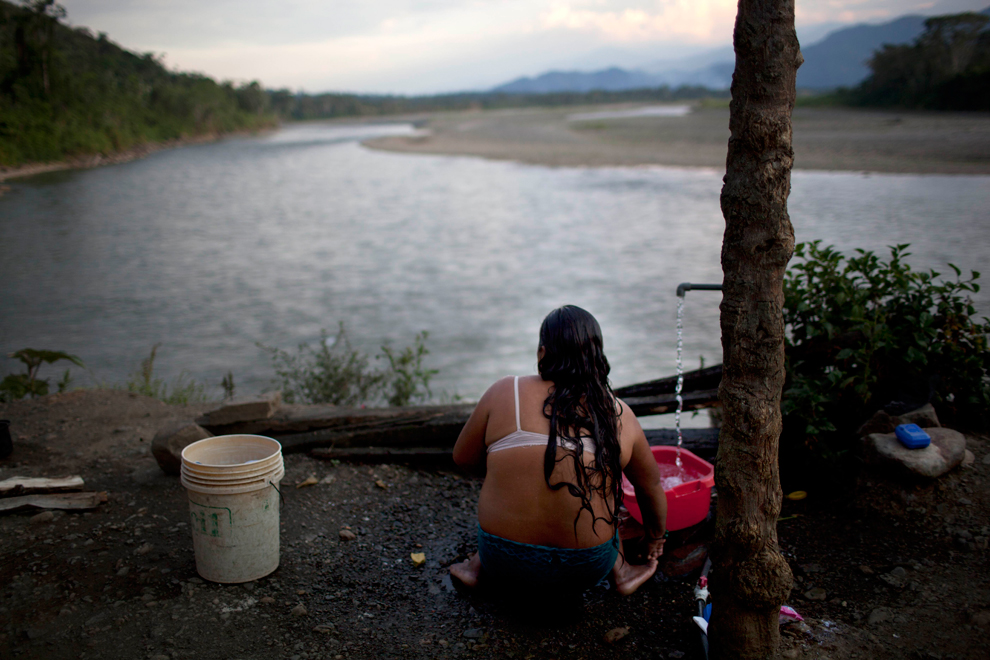
A woman bathes at a communal water faucet above the Apurimac river, in the Trincavini community of PeruÃs Pichari district. The village lies at the center of the world's No. 1 coca-growing valley in a region that the United Nations says yields 56 percent of Peru's coca leaves

Boatmen await customers to ferry across the Apurimac river, in Pichari, Peru, which is at the center of a valley that the United Nations says yields 56 percent of Peru's coca leaves. PeruÃs government is expanding its presence in the vally to combat the cocaine trade.
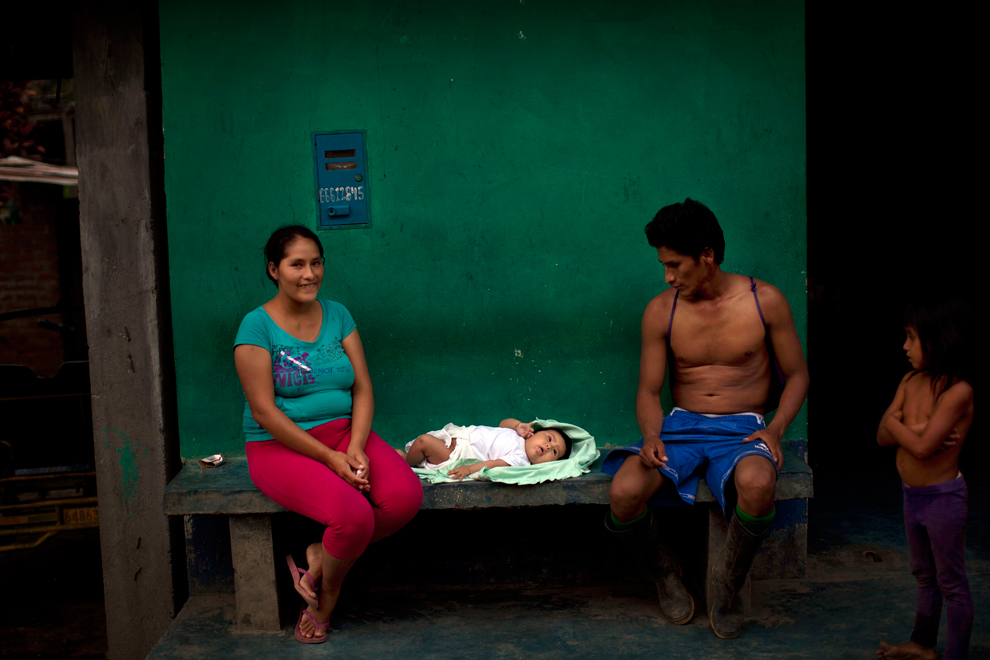
Seeking respite from the oppressive heat inside her home, Norma Taipi, 23, with her 2-month-old daughter Mirella, sits on a storefront bench as she visits with neighbors in Trincavini, a community in PeruÃs Pichari district. Pichari lies on the banks of the Apurimac river at the center of the world's No. 1 coca-growing valley. Coca is the lifeblood of the economy in Pichari, a mostly rural municipality of 40,000 people.
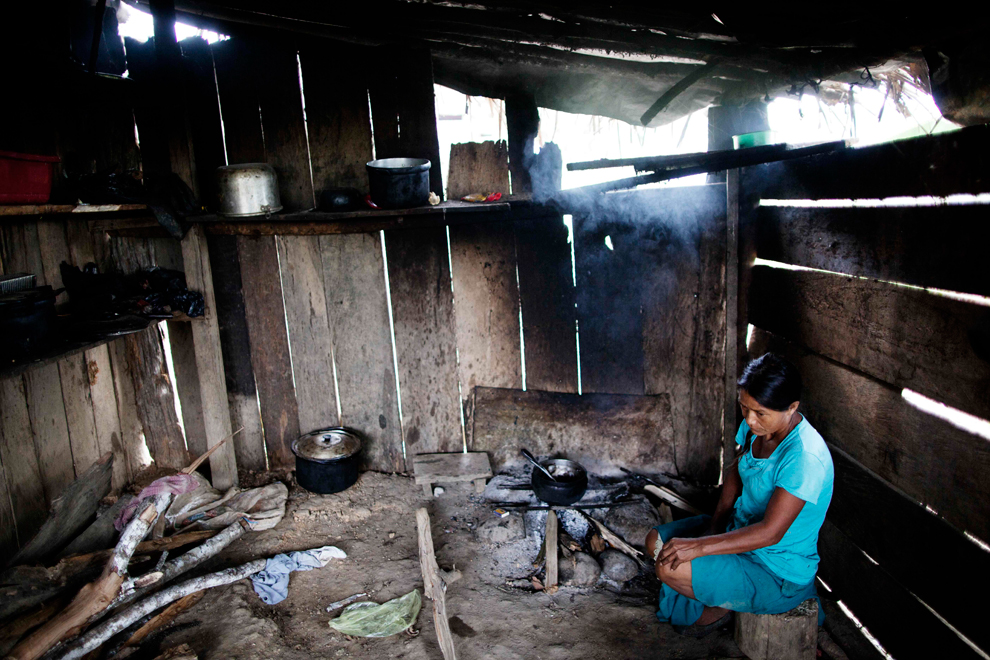
Coca farmer Clementina Gonzalez rests in her kitchen while she heats lunch for her family in the village of Los Angeles in PeruÃs Pichari district. Coca is central to rituals and religion in Andean culture but in recent decades has become more closely associated globally with drug trafficking. In its efforts to discourage coca cultivation, the government encourages farmers to plant alternative crops such as cacao and coffee.
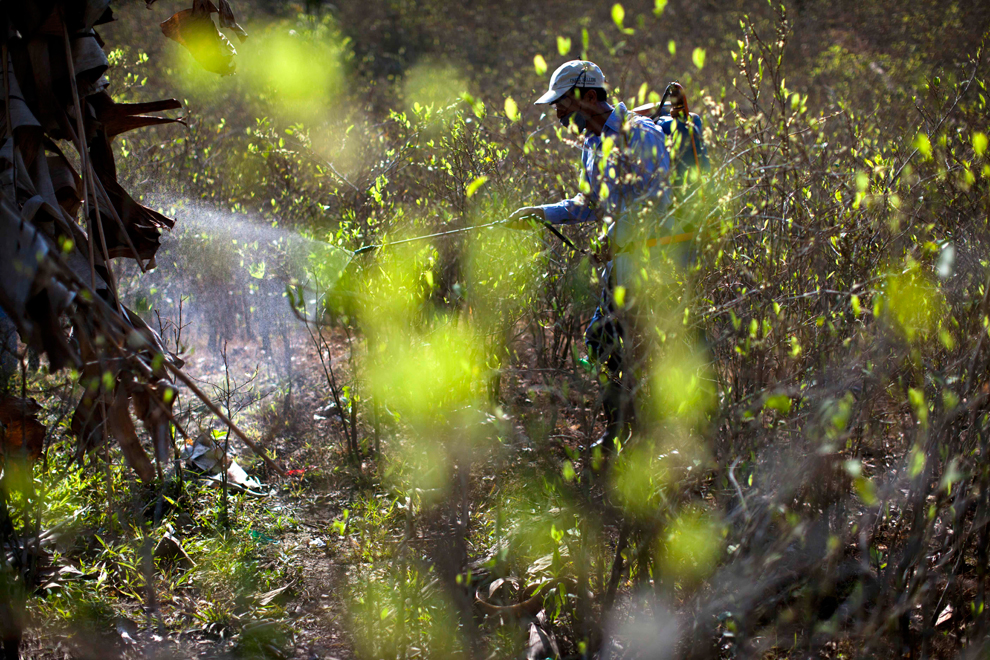
Coca farmer Hugo Tacuri sprays his field in Pichari, Peru, which lies in the world's No. 1 coca-producing valley. Coca is the lifeblood of the economy of the mostly rural municipality of 40,000 people. Although it has eradicated coca elsewhere in the country, Peru's government has not yet attempted to do so in Pichari, in part because of the presence of leftist rebels who live off the cocaine trade.
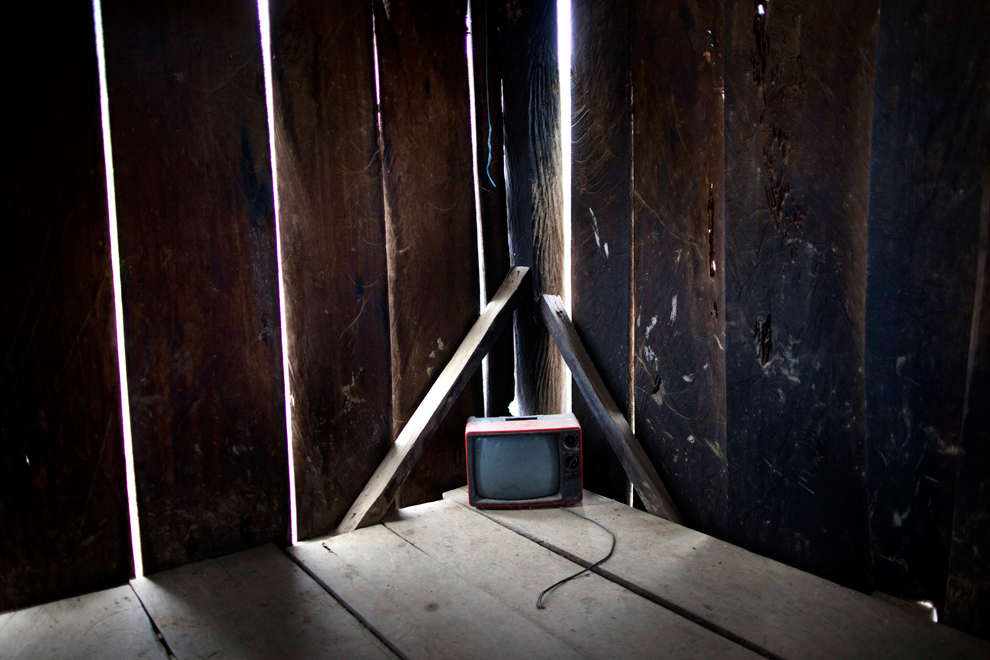
A discarded television set decorates a corner of a coca farmers' home, in Pueblo Libre community, in the Pichari district, Peru. Cultivation of coca leaf is so much a part of Pichari life, the basis of cocaine. The government's anti-drug strategy is to get farmers to grow alternative crops such as cacao and coffee but the benefits of the illicit crop are difficult to overcome when the leading cash crop can be harvested four times a years.
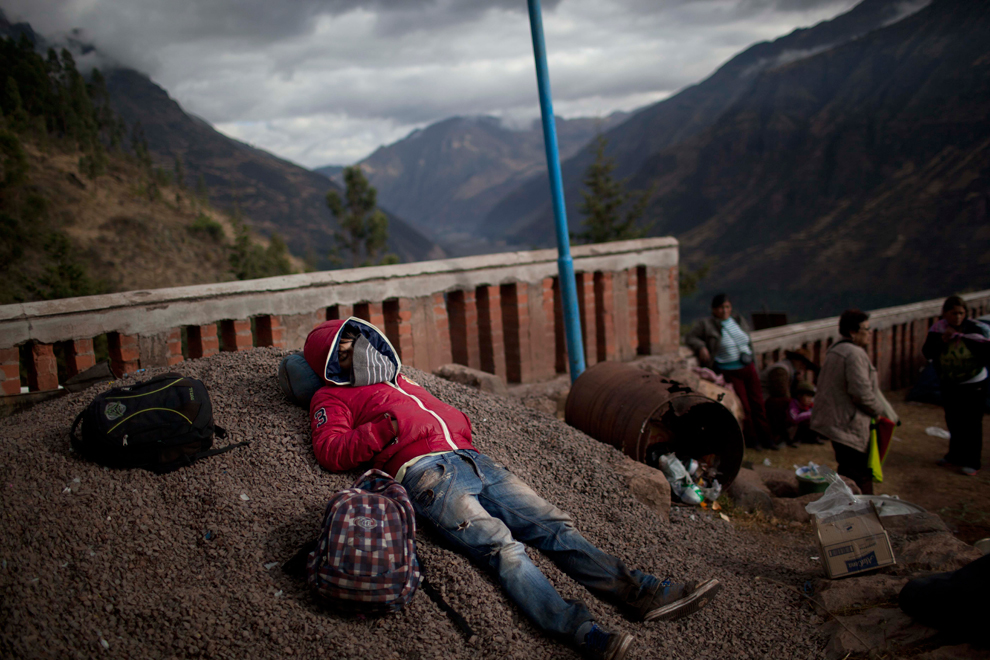
A pilgrim sleeps on a gravel pile on Sept. 14 outside the Lord of Huanca Sanctuary, near Cuzco, Peru. Every year thousands of faithful trek for seven hours up to the foot of PeruÃs Pachatusan mountain to pay homage to the Lord of Huanca, an image of Jesus Christ, scourged and bleeding, that tradition says was painted in a cave 339 years ago. Devotees hike up to the sanctuary on the eve of Sept. 14 carrying candles and flowers, a religious tradition that began in colonial times and last for 3 days
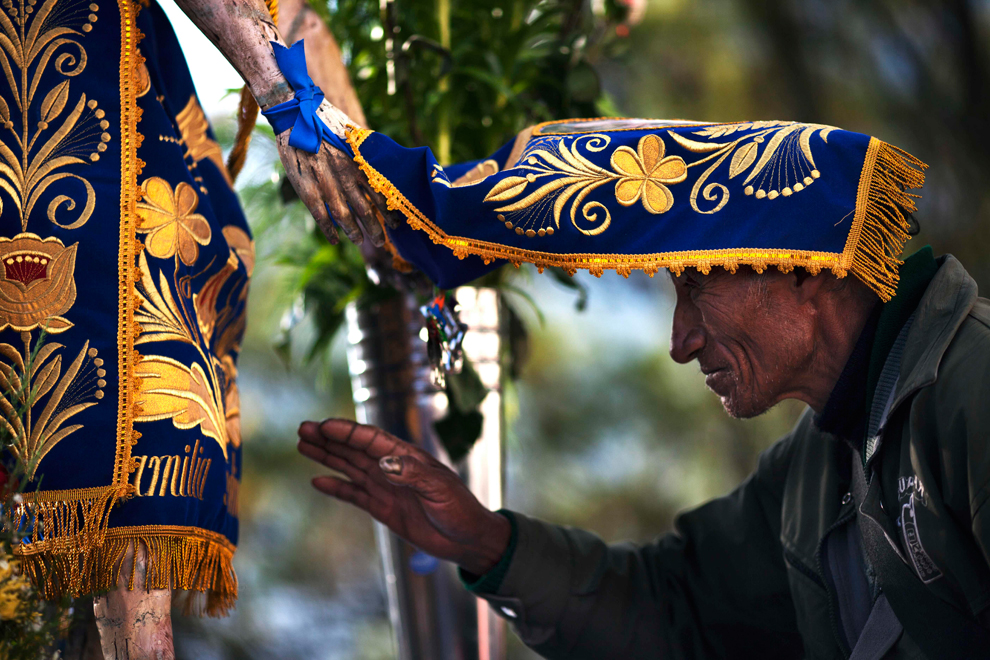
A man reaches out to touch a statue of Jesus Christ outside the Lord of Huanca Sanctuary, near Cuzco, Peru. Each year, thousands of devotees from across Peru and neighboring countries come to Cuzco to make the annual seven-hour night hike up the mountain, to the the foot of the sanctuary, to honor a 339-year-old image of Christ scourged and bleeding, known as the Lord of Huanca, on the walls of the shrine, depicted by an anonymous painter. The cult of the Lord of Huanca was officially recognized by the Catholic Church in 1779.
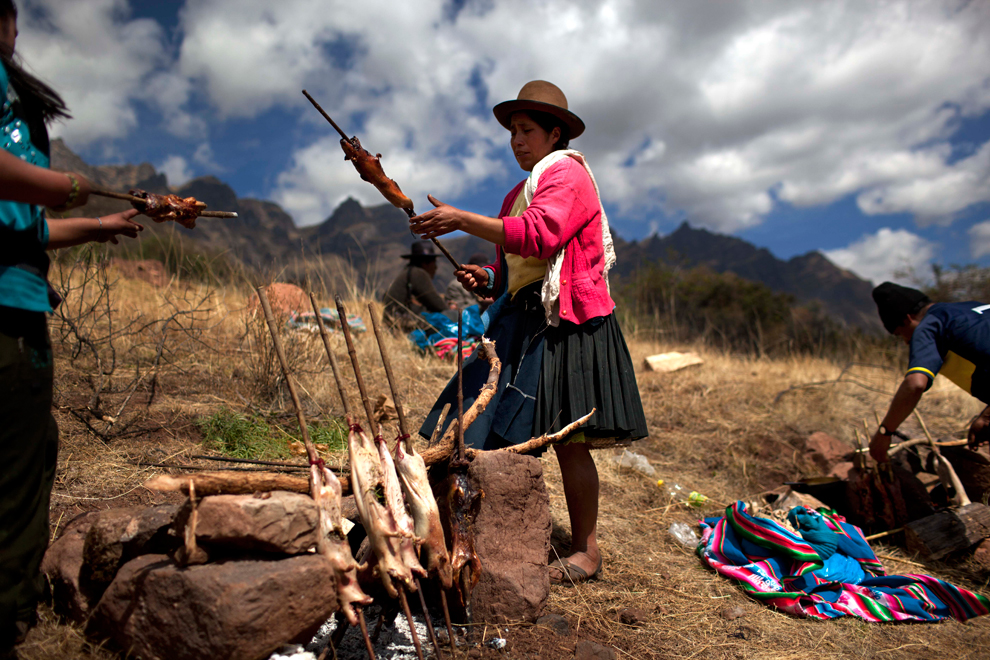
Women cook cuy chactado or fried guinea pigs to sell to pilgrims making the trek to the Lord of Huanca Sanctuary, at the foot of the Pachatusan mountain, near Cuzco, Peru. Each year, thousands of devotees from across Peru and neighboring countries come to Cuzco to make the annual seven-hour night hike up the mountain, to honor a 339-year-old image of Christ scourged and bleeding, known as the Lord of Huanca, on the walls of the shrine. The cult of the Lord of Huanca was officially recognized by the Catholic Church in 1779.

Pilgrims walk towards the Lord of Huanca in Cuzco, Peru. Devotees from across Peru and neighboring countries come to Cuzco to make the annual seven-hour night hike to the mountain, to honor a 339-year-old image of Christ scourged and bleeding, known as the Lord of Huanca, on the walls of the shrine. The 3-day celebration beginning on the eve of Sept. 14, attracts thousands of people carrying candles and flowers to the shrine, which is also accessible by vehicle
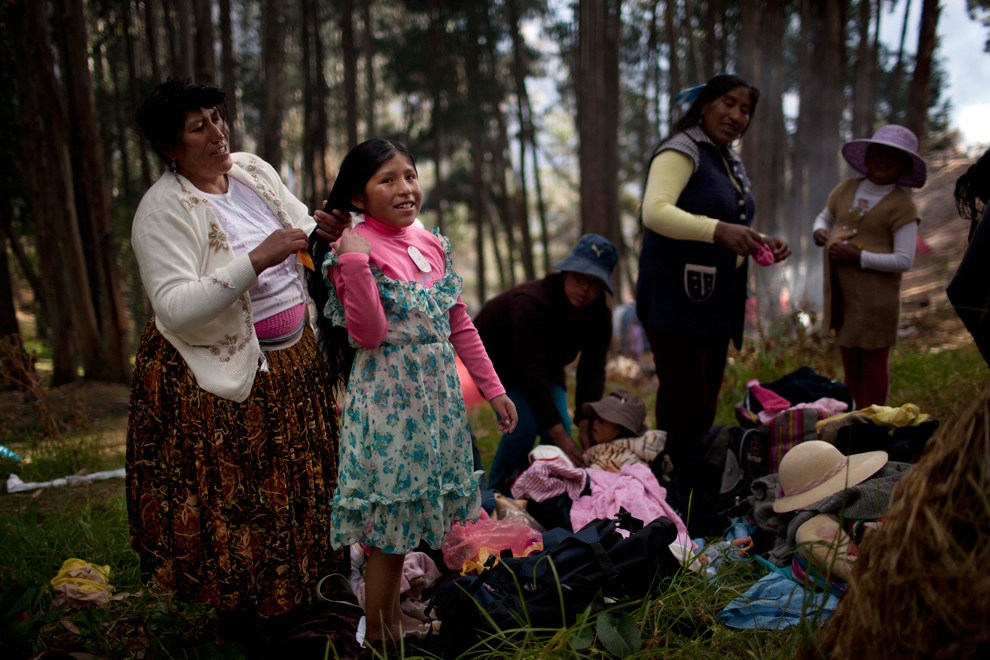
A woman combs the hair of a girl after taking a bath in the waters near the Lord of Huanca Sanctuary, near Cuzco, Peru. Each year, thousands of South Americans from across Peru and neighboring countries make the pilgrimage, some hiking from Cuzco, to the foot of the Pachatusan mountains to honor a 339-year-old image of Christ scourged and bleeding. According to belief, Christ appeared to a man who was hiding inside a cave in Huanca to escape the punishment of his Spanish master. The man later described his vision to an artist who painted the image in the cavern, that became known as the Lord of Huanca.
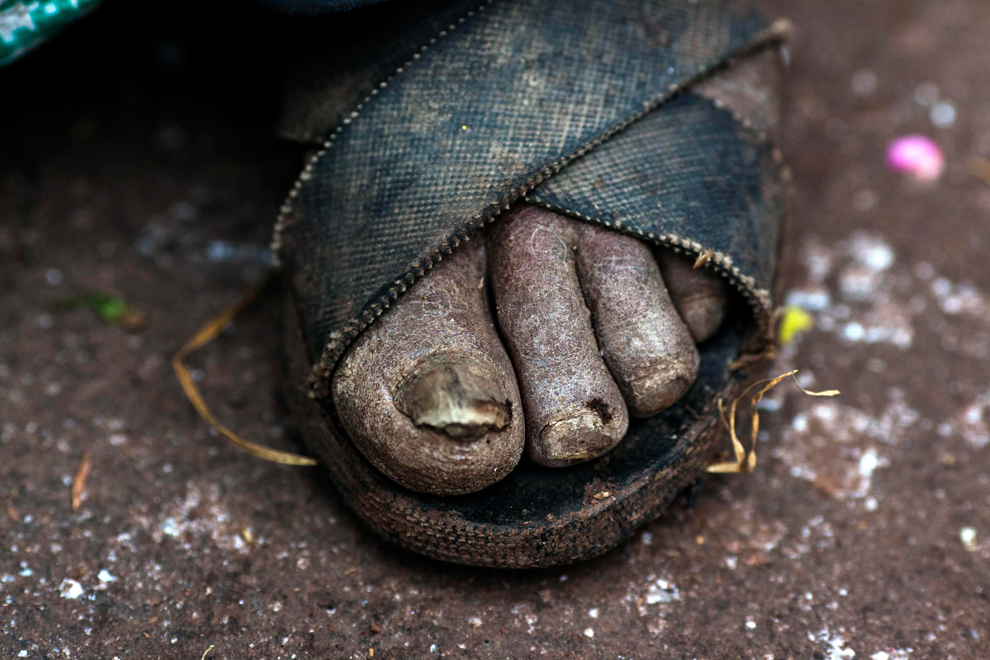
A beggar stands outside the Lord of Huanca Sanctuary, at the foot of the Pachatusan mountain, near Cuzco, Peru. Each year, thousands of devotees from across Peru and neighboring countries come to Cuzco to make the annual seven-hour night hike to the mountain, to honor a 339-year-old image of Christ scourged and bleeding, known as the Lord of Huanca, on the walls of the shrine, depicted by an anonymous painter. The cult of the Lord of Huanca was officially recognized by the Catholic Church in 1779
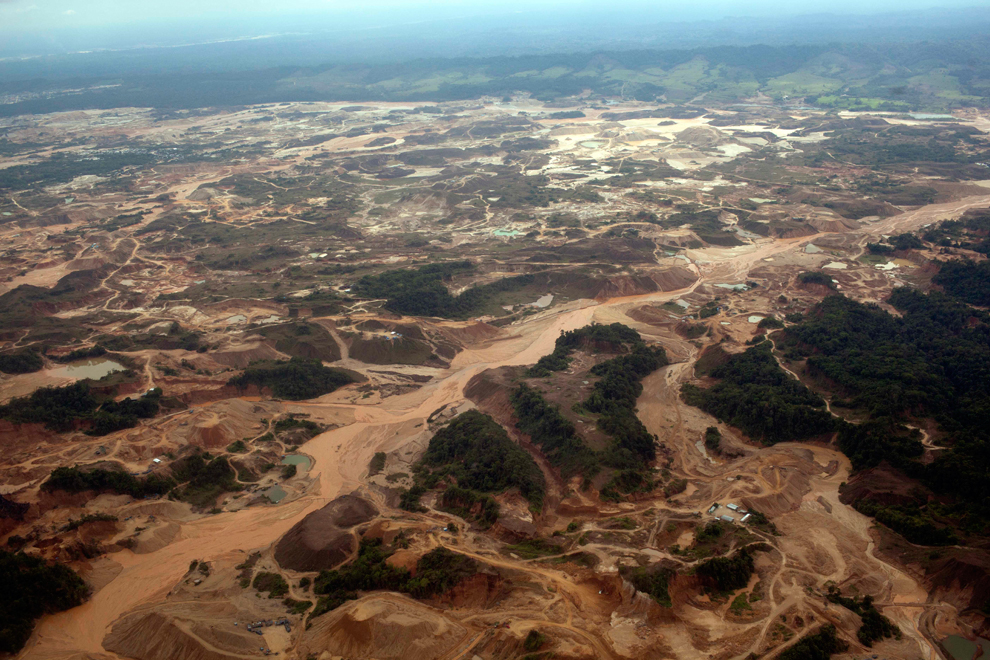
An aerial photo shows tailings produced by informal mining in Peru's Madre de Dios region. A study of mercury contamination from rampant informal gold mining in Peru's Amazon says indigenous people who get their protein mostly from fish are the most affected, particularly their children. The new research conducted by Carnegie Institution for Science found mercury levels above acceptable limits in 76.5 percent of the people living in the Madre de Dios region, both rural and urban populations.
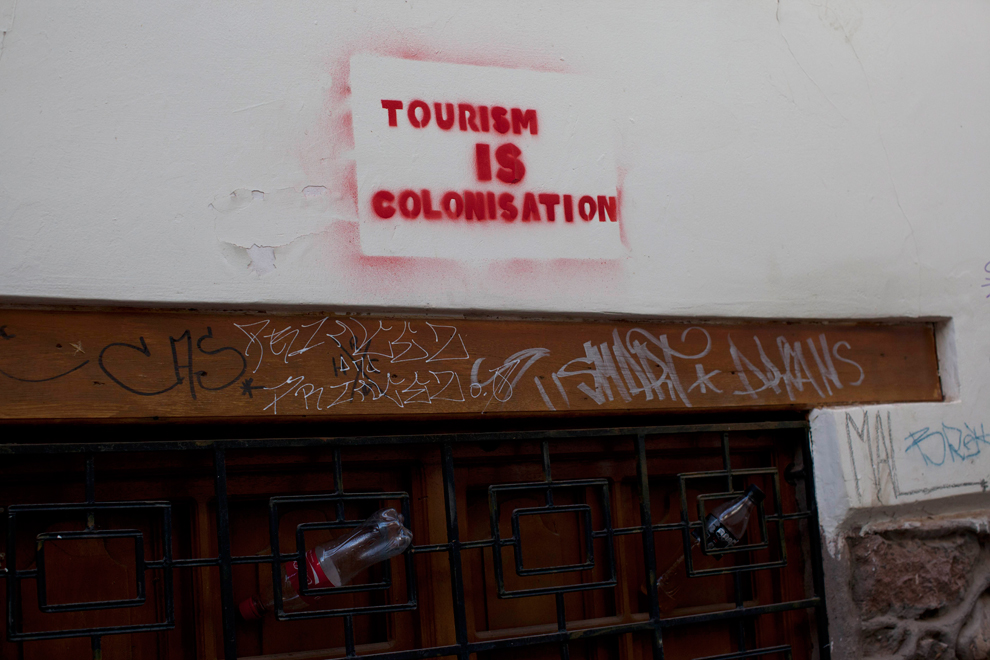
A spray-painted stenciled message that reads in Spanish; "Tourism is Colonization,"is seen on the facade of a private residence in Cuzco, Peru, on Sept. 13. The national government has approved what will be Peru's first aerial tramway to the Choquequirao ruins near Cuzco. The idea is to shift some of the tourist burden from Machu Picchu, where authorities have a limit of 2,500 daily visitors and where reservations are now required for people who wish to hike the famed Inca Trail to the ruins.
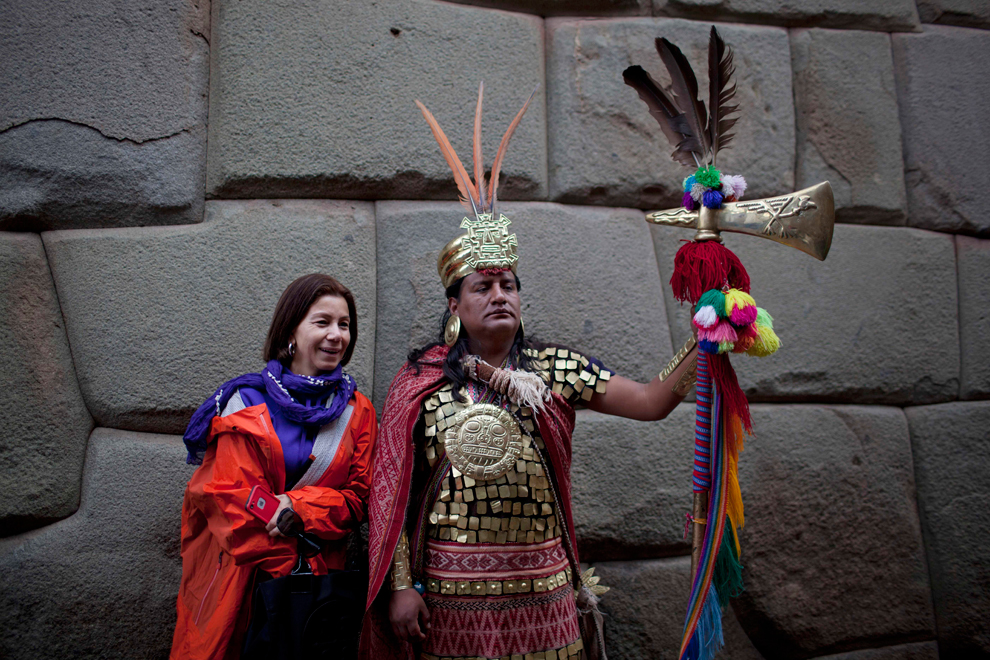
A tourist poses for a photo with a Peruvian dressed as Inca ruler Manco Capac, a mythological figure also known as the "Only Son of the Sun God Inti," stands in front of the famous wall that contains the stone of twelve angles on Hatunrumiyoc street, in Cuzco, Peru, on Sept. 13. The wall crafted by Inca masons, feature precisely cut and shaped stones closely fitted without the use of clay or mud.
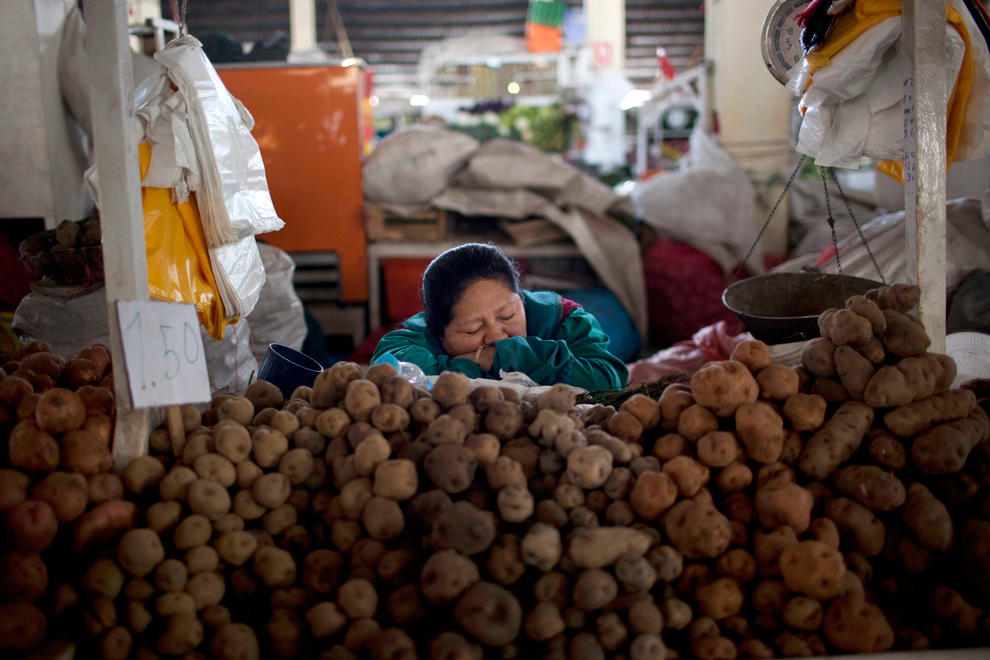
A potato vendor takes a catnap as she waits for customers at the San Pedro market in downtown Cuzco, Peru, on Sept. The potato is a source of Peruvian national pride, with some 3,000 varieties reportedly cultivated in the country.
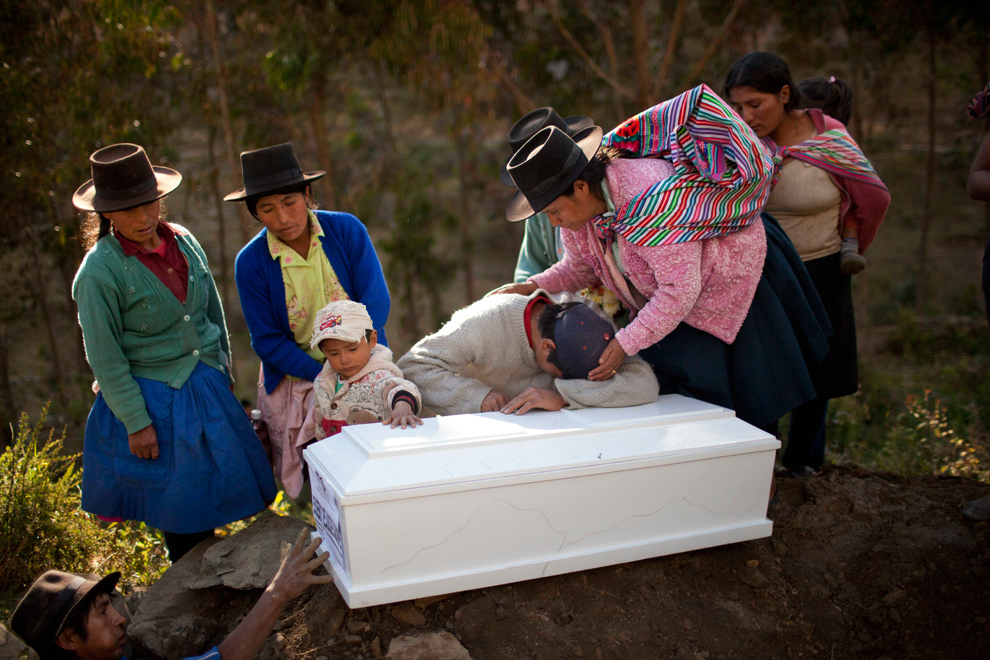
Eusebio Velasque mourns on June 15 over the coffin containing the remains of his father Edwin Velasque during a mass burial at the local cemetery in Chaca, Peru. Velasque is one of the Chaca residents tortured and killed on Jan. 8,1988 by Shining Path militants in retaliation for forming a self-defense committee. Their remains were exhumed in 2012 from a mass grave and released to family members
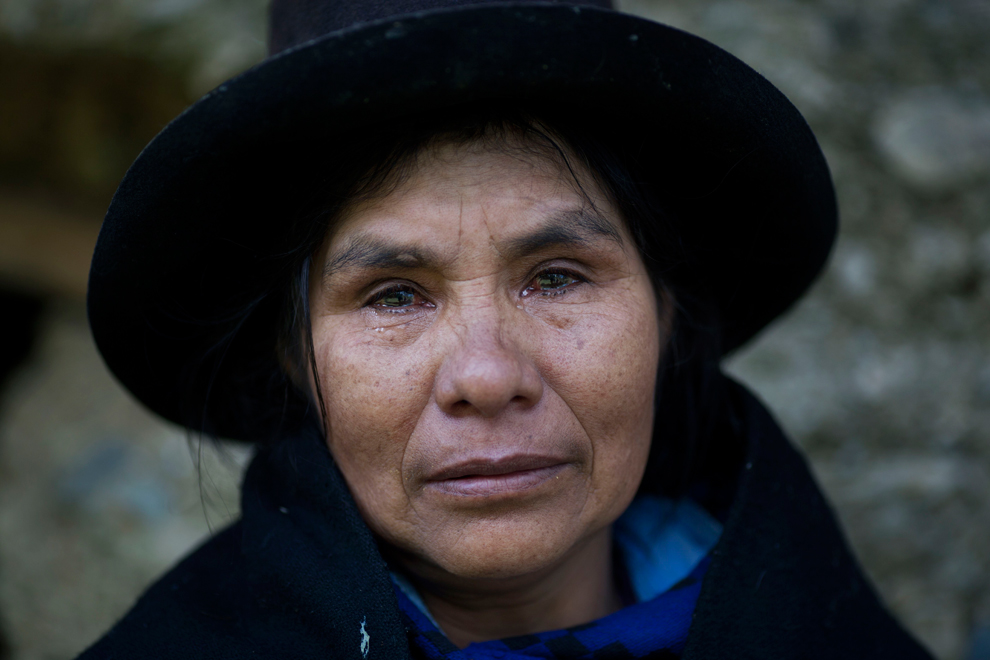
Eudicia Urbano, 70, standing in front of her former home, near the spot where her husband Marcial Escalante died, weeps as she retells how he was tortured and killed by Shining Path rebels, in Chaca, Peru. The region endured some of the worst atrocities of PeruÃs 1980-2000 conflict, in which both Maoist-inspired insurgents and security forces committed grave human rights violations.
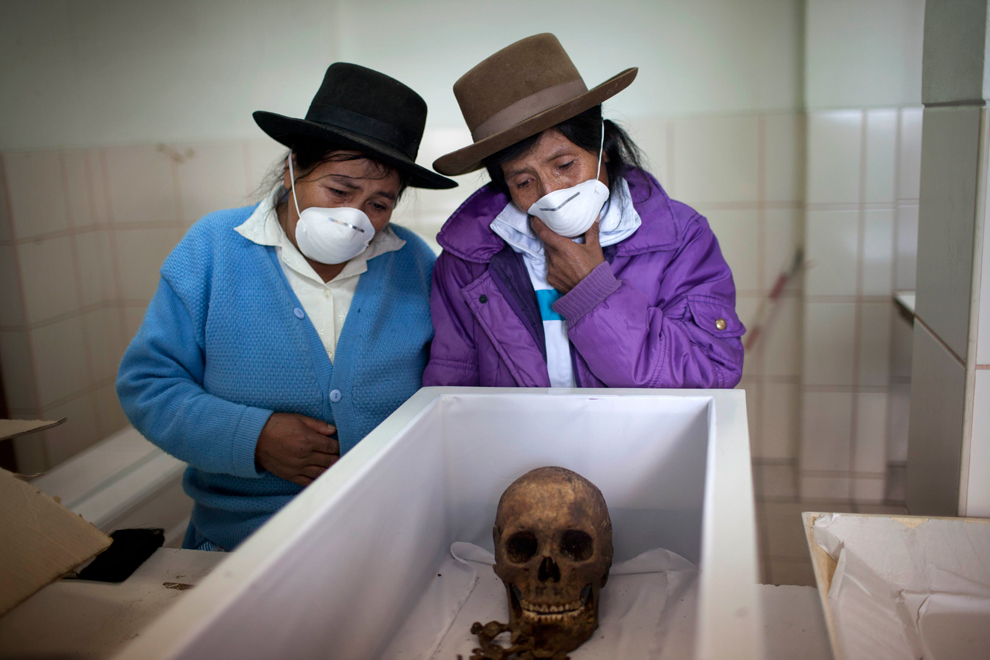
Aquilina Cardenas, right, and her sister Luciana look into the coffin containing the remains of their father in a forensic laboratory in Ayacucho, Peru on June 13. Their father is one of the Chaca residents tortured and killed on Jan. 8,1988 by Shining Path militants in retaliation for forming a self-defense committee. The remains of the victims were exhumed in 2012 from a mass grave and released to family members, followed by a mass burial in Chaca.
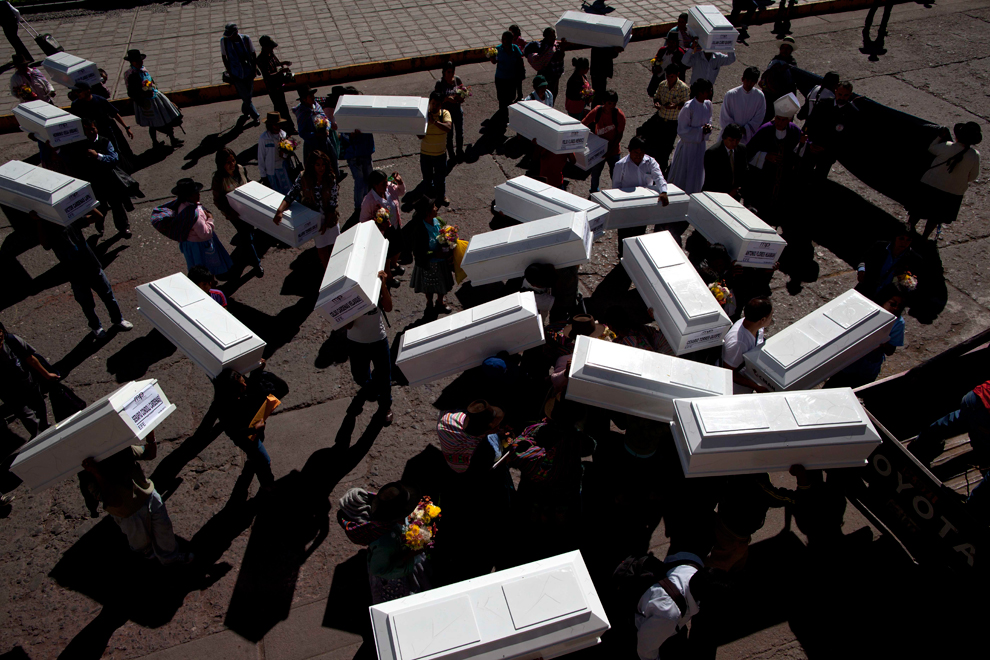
After attending a brief memorial service marking the return of their relatives' exhumed remains, family members carry coffins containing the remains through the main square in Ayacucho, Peru, before returning to Chaca for a mass burial. The remains were exhumed in 2012 from a mass grave and released to family members on June 13. The victims were killed in 1988 by Shining Path militants in retaliation for forming a self-defense committee.
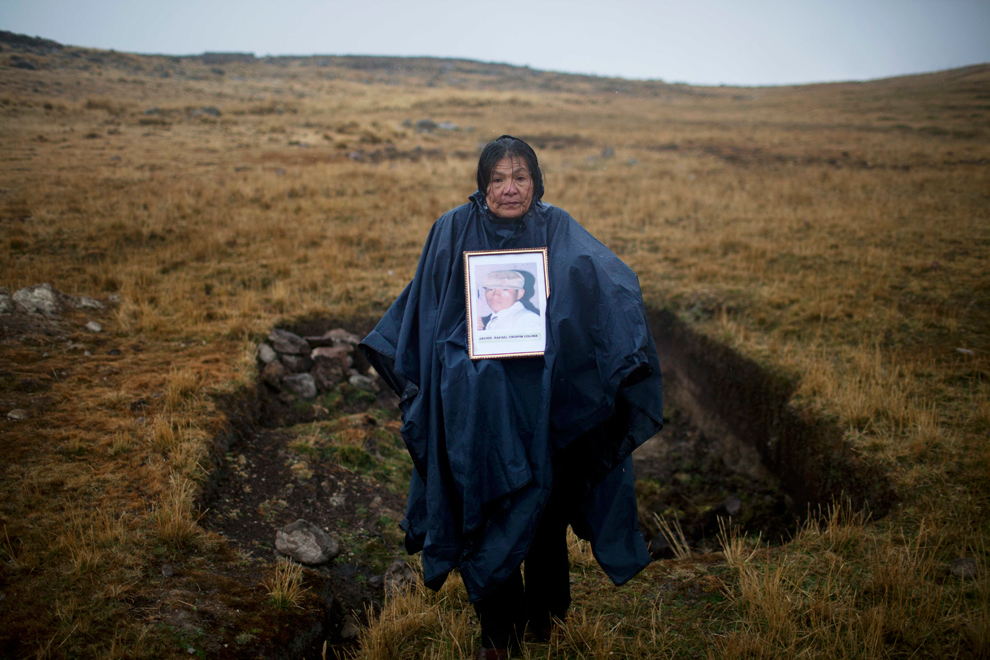
Alicia Isabel Colina, 61, poses for a photo holding a portrait of her disappeared son, Javier Crispin Colina, in front of mass grave number 70, discovered by Colina and her husband, in Huancavelica, Peru. For almost a quarter century Colina and her husband scoured the mountains of Peru's poorest region in search of the son hauled away by soldiers from a friend's house in the middle of the night. Completely on their own, the couple found a total of 70 clandestine burial sites and unearthed three dozen bodies.
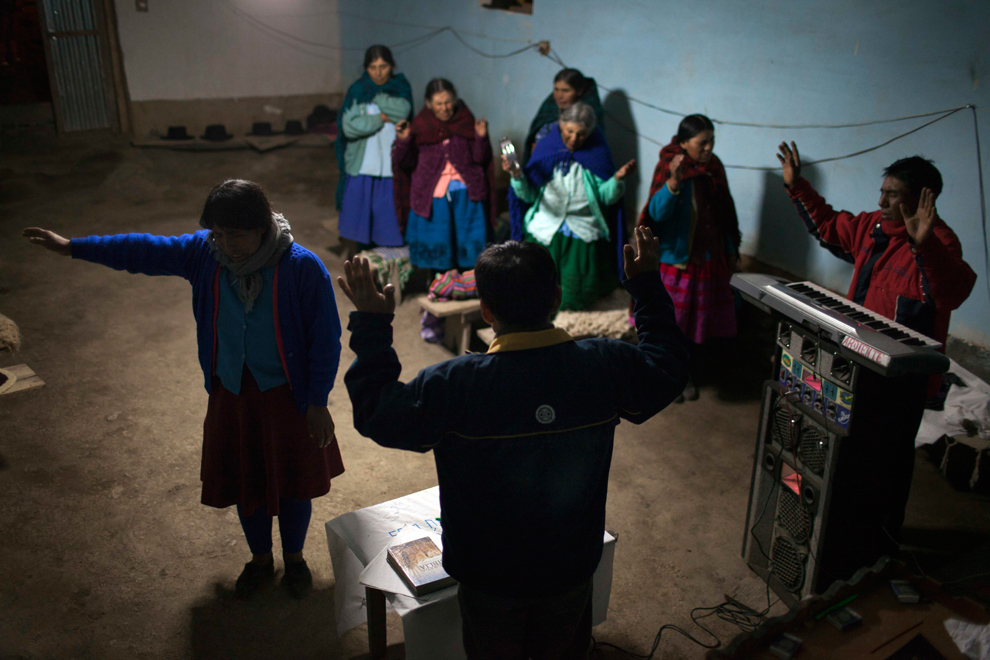
Villagers pray at the end of the day during an evangelical service, after attending a mass burial of other villagers slain by insurgents nearly three decades ago, in Chaca, Peru. A Truth and Reconciliation Commission estimated that Peru's 1980-2000 conflict claimed nearly 70,000 lives, most of them poor, Quechua-speaking people. Some 15,000 of them disappeared. Yet fewer than 3,000 bodies have been exhumed because the country has lagged in healing the wounds of its war.
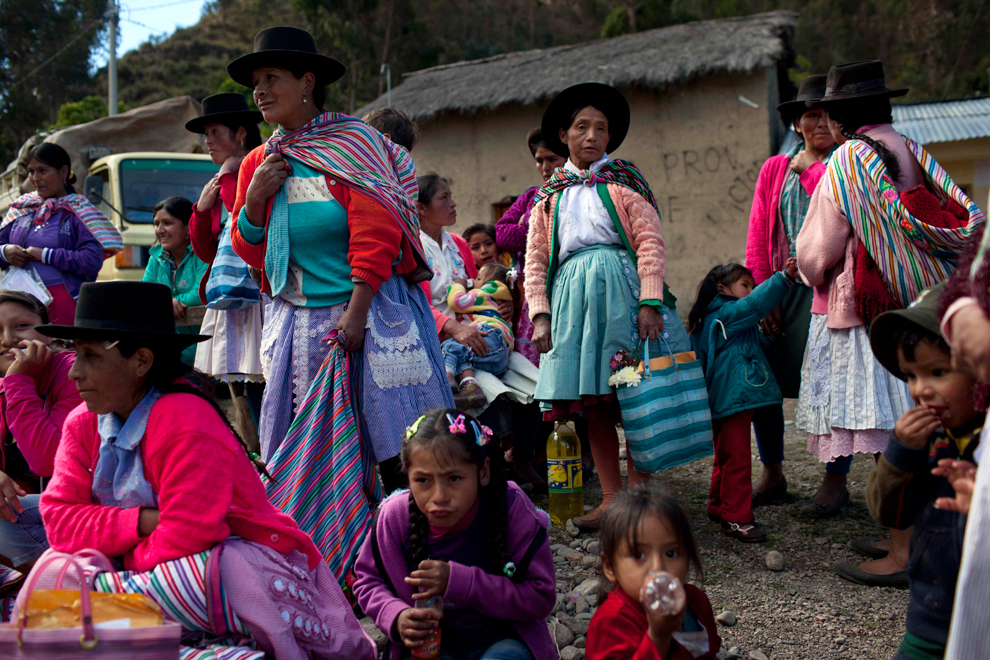
Women out on Market Day gather in the main square minutes before the arrival of the coffins containing the remains of residents killed in a 1988 massacre, in Chaca, Peru. The remains of residents that were exhumed in 2012 from a mass grave and released to family members on June 13 were interred in a mass burial at the Chaca cemetery. On Jan. 8, 1988, a group of Chaca residents were tortured and killed by Shining Path militants, in retaliation for forming a self-defense committee. As weapons the villagers had little more than slingshots and poles with knives affixed.
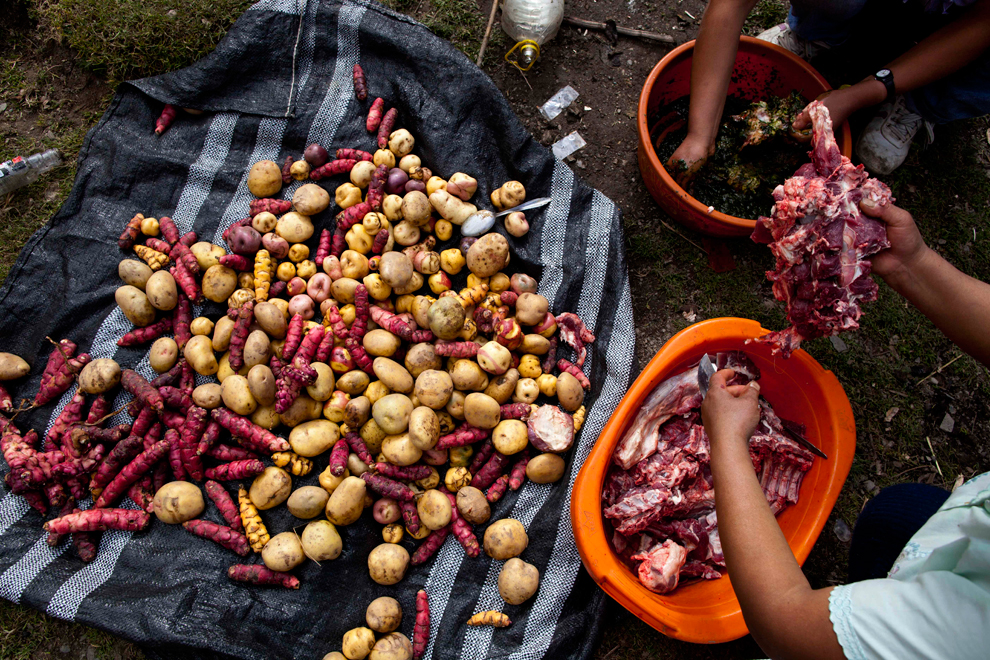
Women prepare "Pachamanca," a feast of meats, vegetables and herbs, buried in a pit along with hot stones and roasted, in honor of a mass burial and to mark Father's Day, in Chaca, Peru. The remains of residents that were exhumed in 2012 from a mass grave and released to family members on June 13 were interred in a mass burial at the Chaca cemetery. On Jan. 8, 1988, a group of Chaca villagers were tortured and killed by Shining Path militants in retaliation for forming a self-defense committee.
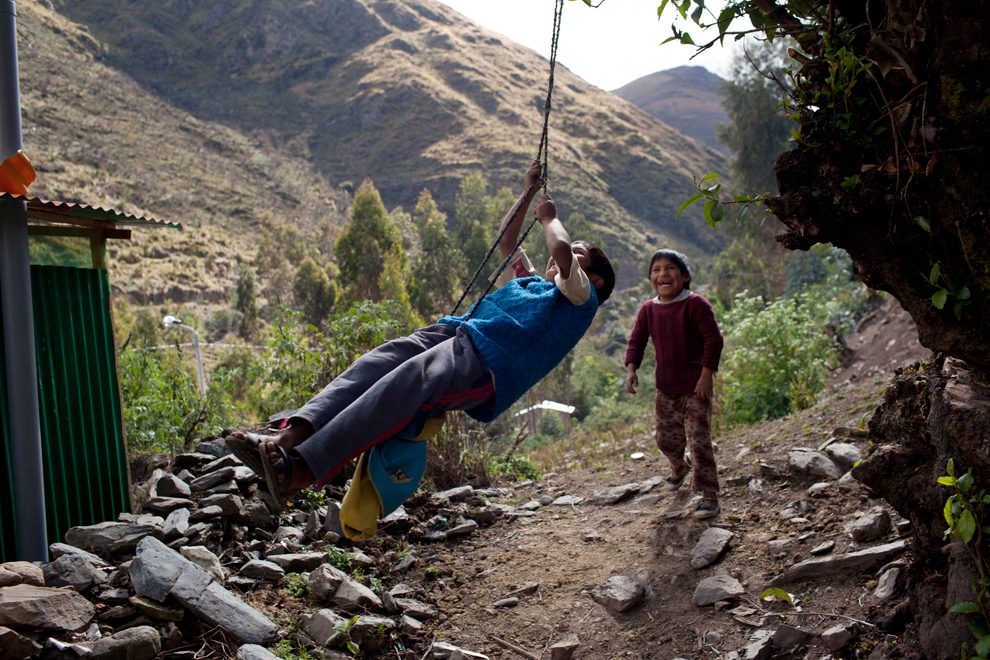
A boy pushes another in a makeshift swing in Chaca, Peru, a remote region of Ayacucho state that endured some of the worst atrocities of PeruÃs 1980-2000 conflict. Chaca is among thousands of communities still waiting for reparations money promised by the state eight years ago. It lacks running water and telephone service, medical attention is precarious and, during the four-month rainy season, it's inaccessible by vehicle as the dirt road link becomes mud.

Simeon Velasque, left, holds a plastic bottle filled with liquor as he sits with his wife, Aurora Saume, in Chaca, Peru. Velasque joined earlier in the day other relatives of villagers slain by insurgents nearly three decades ago to formally bury the remains the victims, including his father, exhumed last year from a common grave in the remote Ayacucho state hamlet. No state agency exists dedicated to locating and cataloguing the conflictÃs estimated 15,000 disappeared. The bodies of fewer than 3,000 have been exhumed.
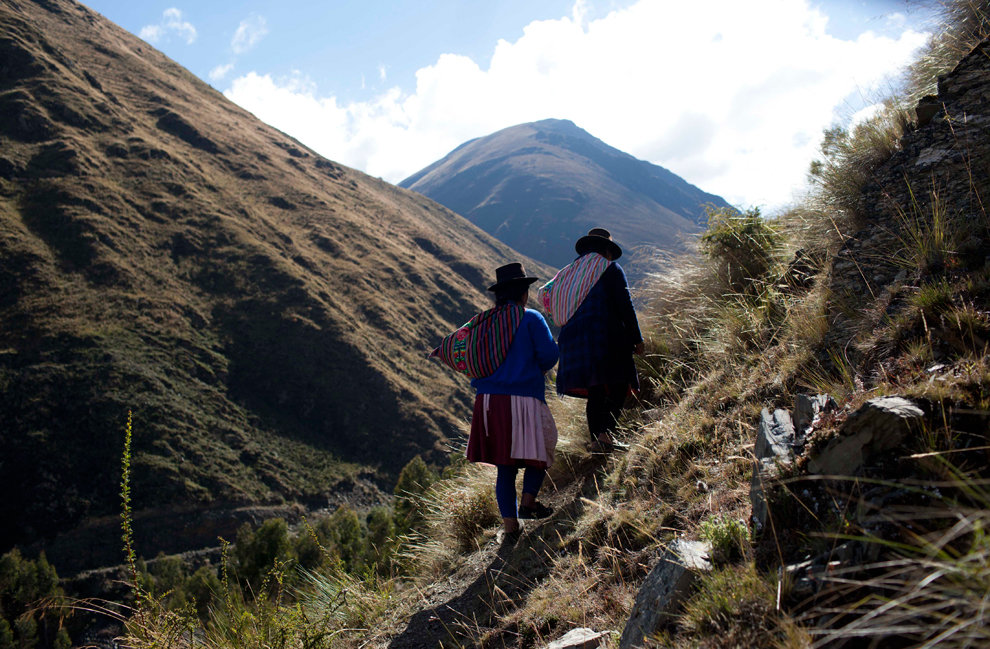
Accompanied by her daughter-in-law Gregoria Lapa, Eudicia Urbano, 70, walks to her former home, where her husband, Marcial Escalante, was tortured and killed by Shining Path rebels, in Chaca, Peru. Escalante remains were buried the day before, in a mass burial along with other Chaca residents tortured and killed in 1988 by Shining Path militants. A full decade after a Truth and Reconciliation Commission released a report on the conflict that claimed nearly 70,000 lives, activists say few of its recommendations have been heeded, in large part because most of the victims were poor, Quechua-speaking highlands peasants like Escalante
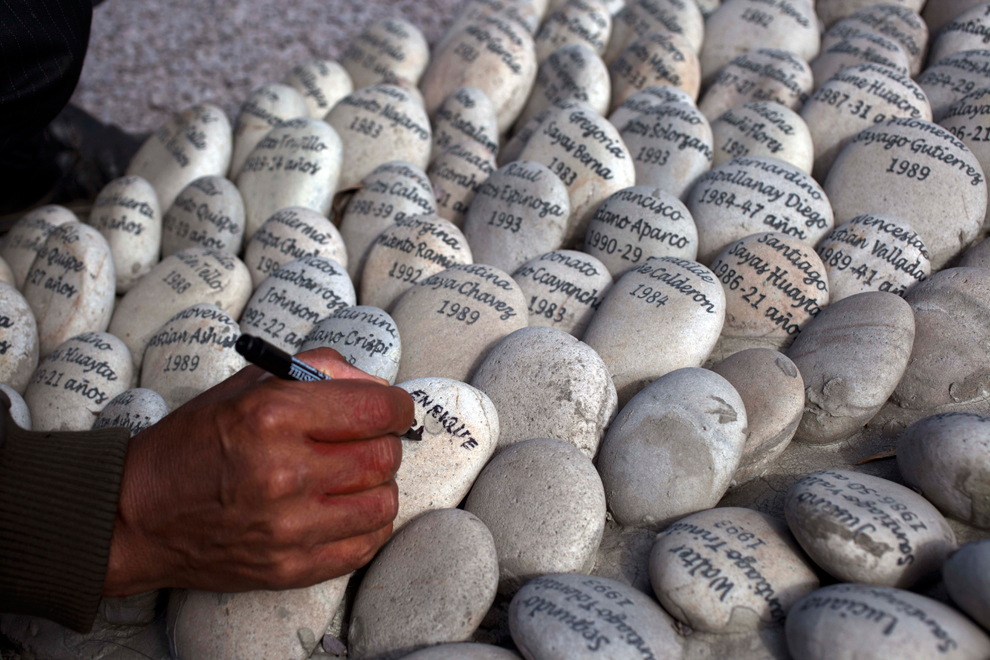
Simeon Irrazabal writes the name of his father, who he said was killed by the Peruvian army in 1987, at the "Ojo que Llora" memorial, or "Eye that Cries" memorial in Lima, Peru, on Aug. 28. Peru is marking the 10th anniversary of the final report by The Truth and Reconciliation Commission (TRC), regarding the bloody conflict between the Peruvian government and the Shining Path insurgency devastated the Andean nation from 1980 to 2000, killing nearly 70,000 people
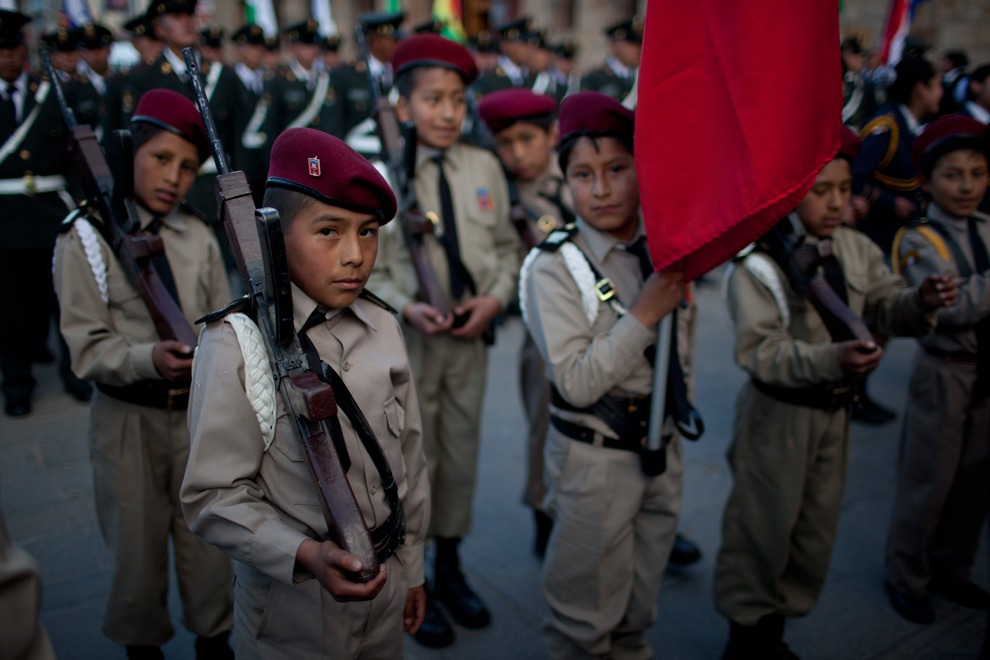
Students dressed as soldiers wait for the start of the memorial service for the Bishop Emeritus of Huancavelica, William Dermott Molloy McDermott, in the main square of Huancavelica, Peru, on Aug. 21. "Bishop Demetrio," as he was fondly called, died on Aug. 19, at the age of 83. The Irish priest arrived in Peru in 1976, embracing the Quechua culture and dominating the language. The bishop emeritus, who was recognized by the Peruvian government for his pastoral work in one of Peru's poorest areas, was laid to rest inside the town's cathedral.
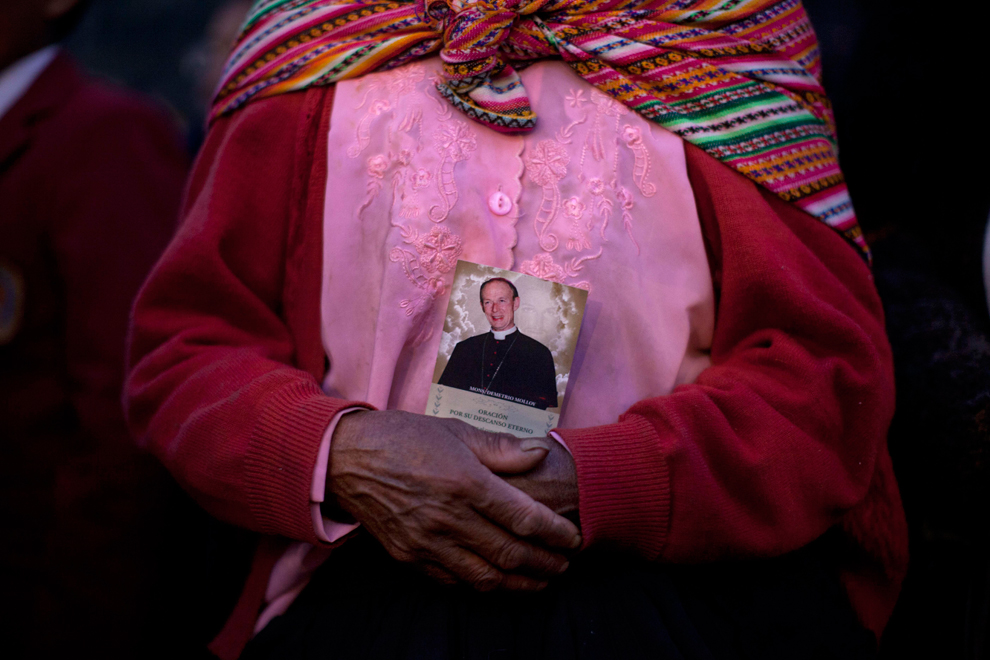
Quechua Rosa Taipe Rodriguez holds an image of the Bishop Emeritus of Huancavelica, William Dermott Molloy McDermott, during a memorial service in the main square of Huancavelica, Peru, on Aug. 21. "Bishop Demetrio," as he was fondly called, died on Aug. 19, at the age of 83. The Irish priest arrived in Peru in 1976, embracing the Quechua culture and dominating the language. The bishop emeritus, who was recognized by the Peruvian government for his pastoral work in one of Peru's poorest areas, was laid to rest in the town's cathedral.
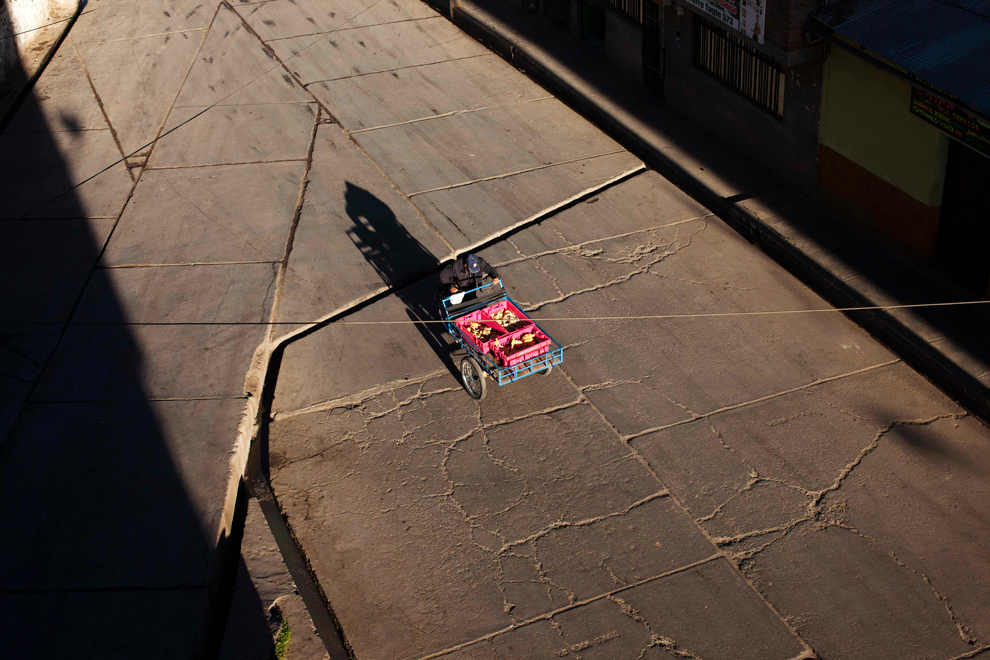
A vendor pushes his cart full of chickens to the market in downtown Huancavelica, Peru
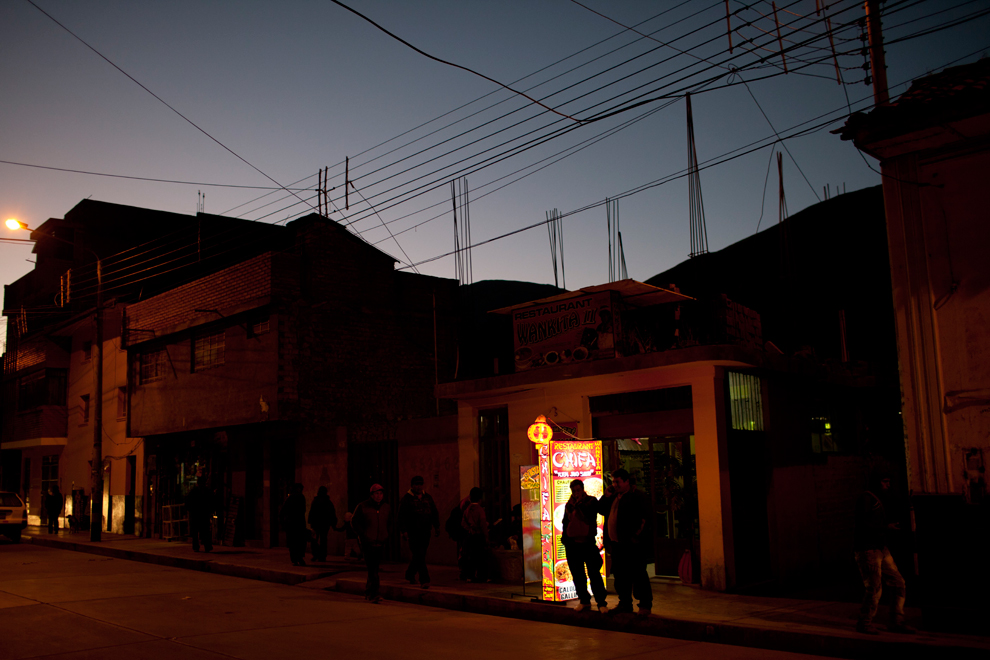
A man is silhouetted against a poster advertising a fusion restaurant for Chinese and Peruvian food called "Chifa," in Huancavelica, Peru
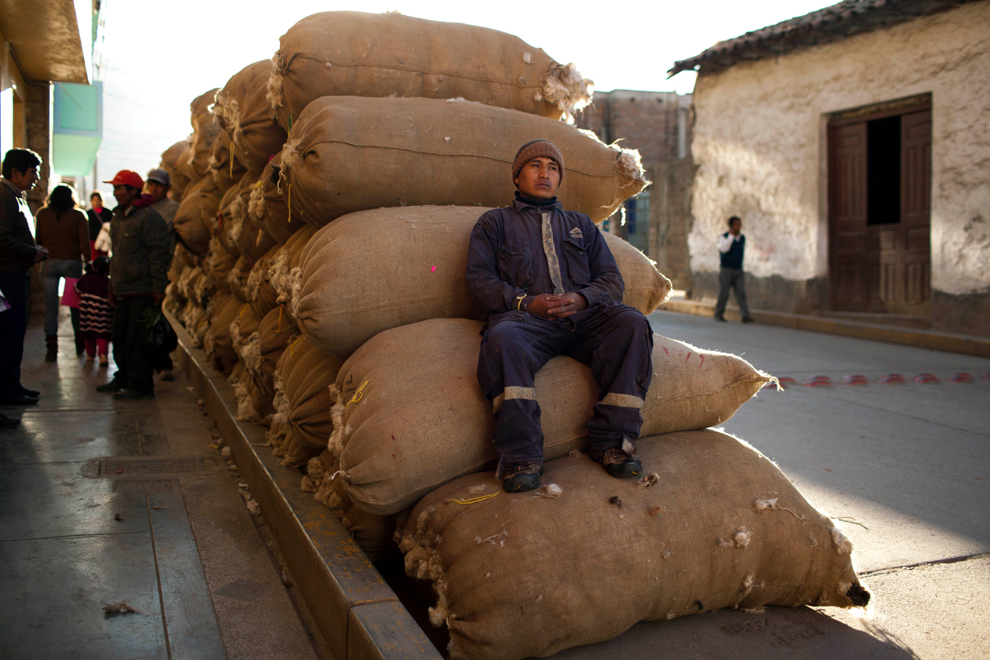
Loader Romulo rests on sacks of wool in downtown Huancavelica, Peru,
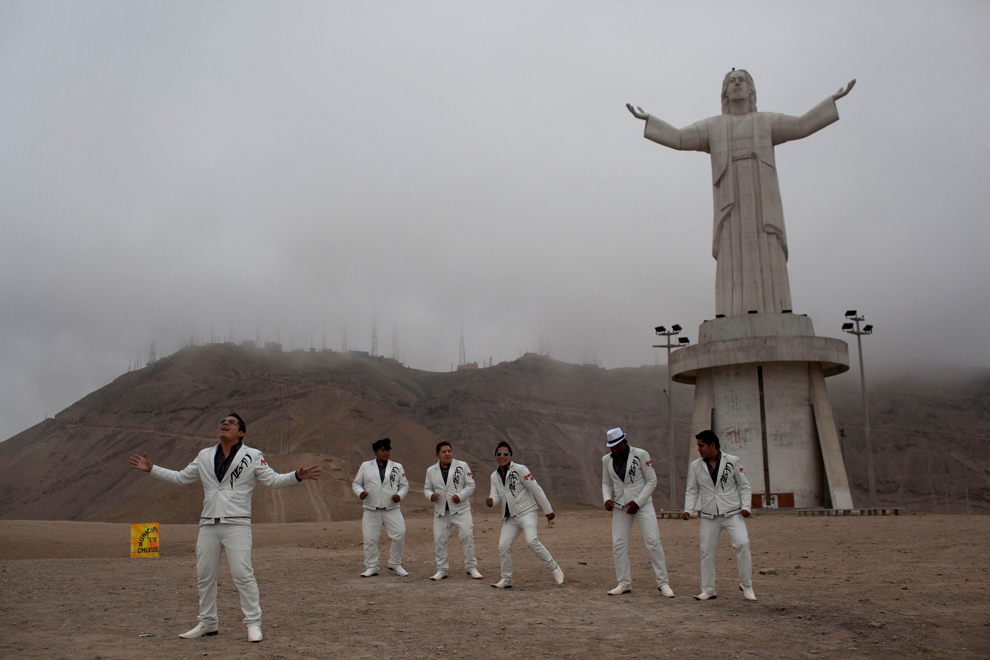
Members of "Amaral", a Cumbia music band, tape a promotional video on July 2 back dropped by the "Christ of the Pacific" statue in Lima, Peru. For roughly four months a year, the sun abandons Peru's seaside desert capital, suffocating it under a ponderous gray cloudbank and fog that coats the city with nighttime drizzles. The cold Humboldt current that runs north from Antarctica along the coast is the culprit, colliding with the warmer tropical atmosphere to create the blinding mists called "garua" in coastal Chile and Peru
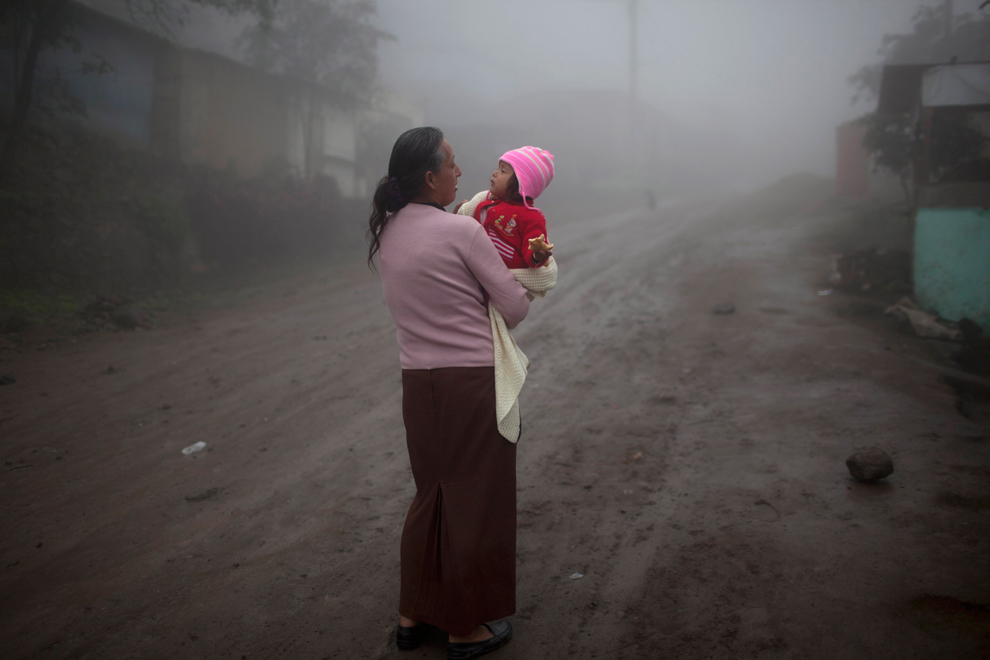
Yunet Valenzuela heads home with her daughter Meliza Abigail Diaz in Lima, Peru, on July 24. For roughly four months a year, the sun abandons Peru's seaside desert capital, suffocating it under a ponderous gray cloud bank and fog that coats the city with nighttime drizzles. Of course no one suffers Lima's winters like the poor huddled in its hilly, fog-draped peripheries.
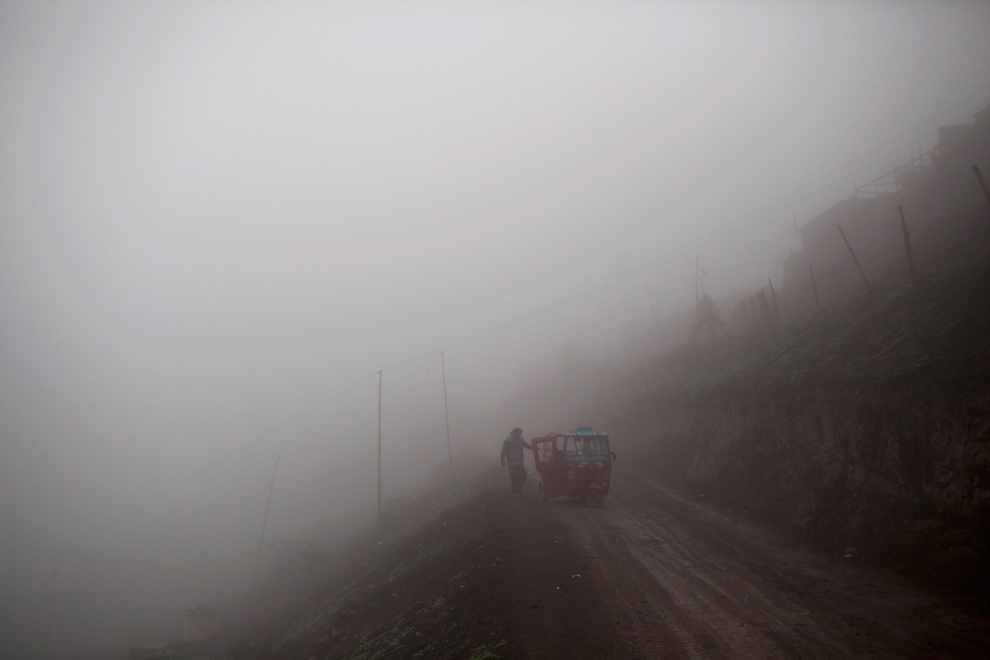
A man approaches his motorcycle taxi during a foggy morning at the Santa Maria neighborhood in Lima, Peru. For roughly four months a year, the sun abandons Peru's seaside desert capital, suffocating it under a ponderous gray cloud bank and fog that coats the city with nighttime drizzles. Of course no one suffers Lima's winters like the poor huddled in its hilly, fog-draped peripheries.
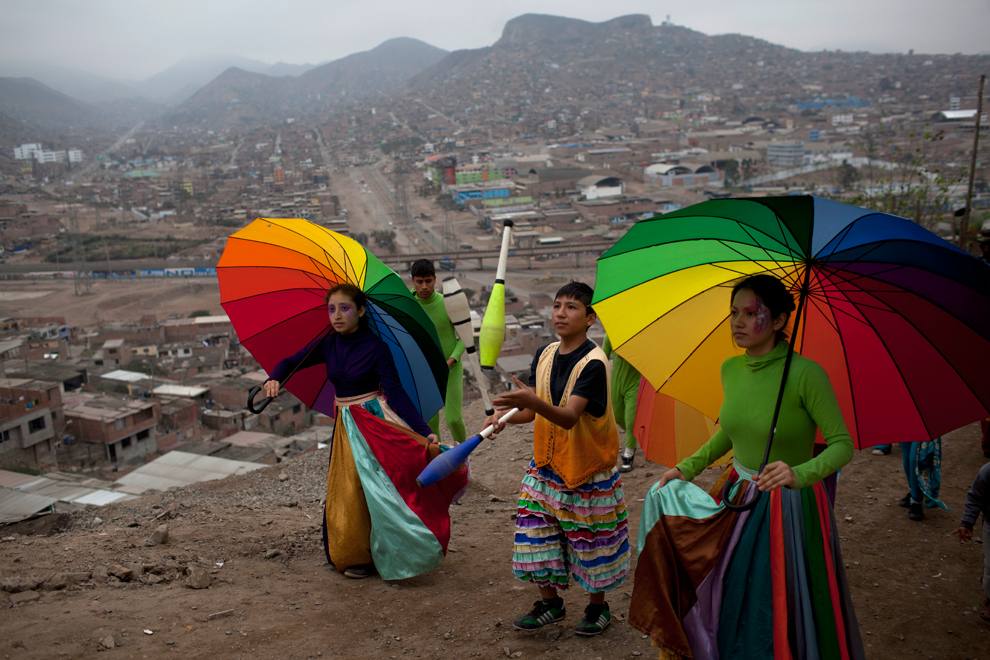
Actors with the theater group "Arena y Esteras" perform at the Villa El Salvador district of Lima, Peru
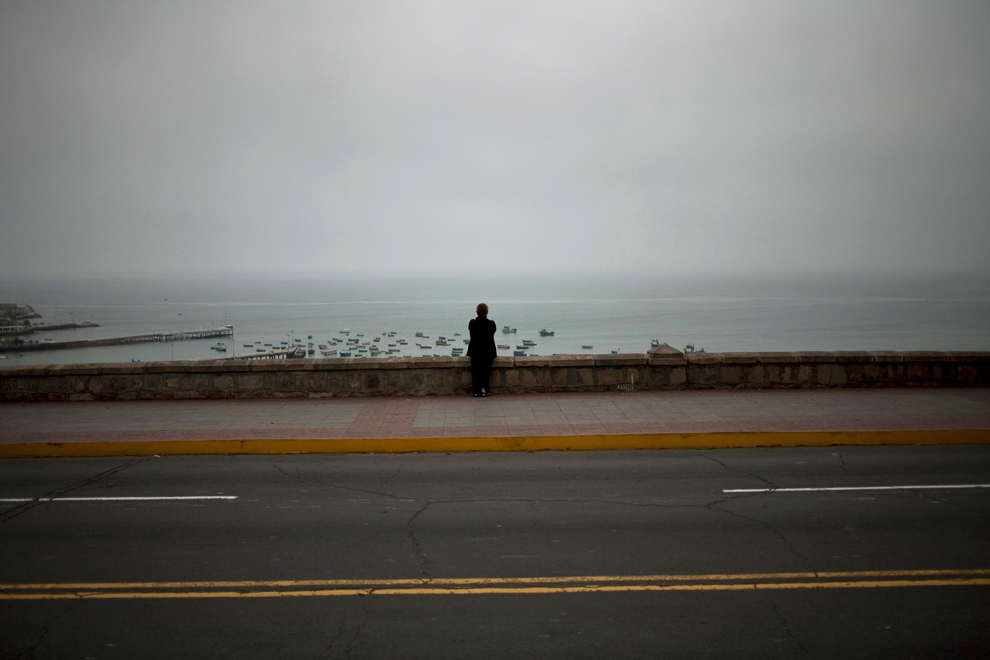
A woman watched the Pacific Ocean from a waterfront promenade on July 3in the Chorrillos neighborhood of Lima, Peru. For roughly four months a year, the sun abandons Peru's seaside desert capital, suffocating it under a ponderous gray cloud bank and fog that coats the city with nighttime drizzles.
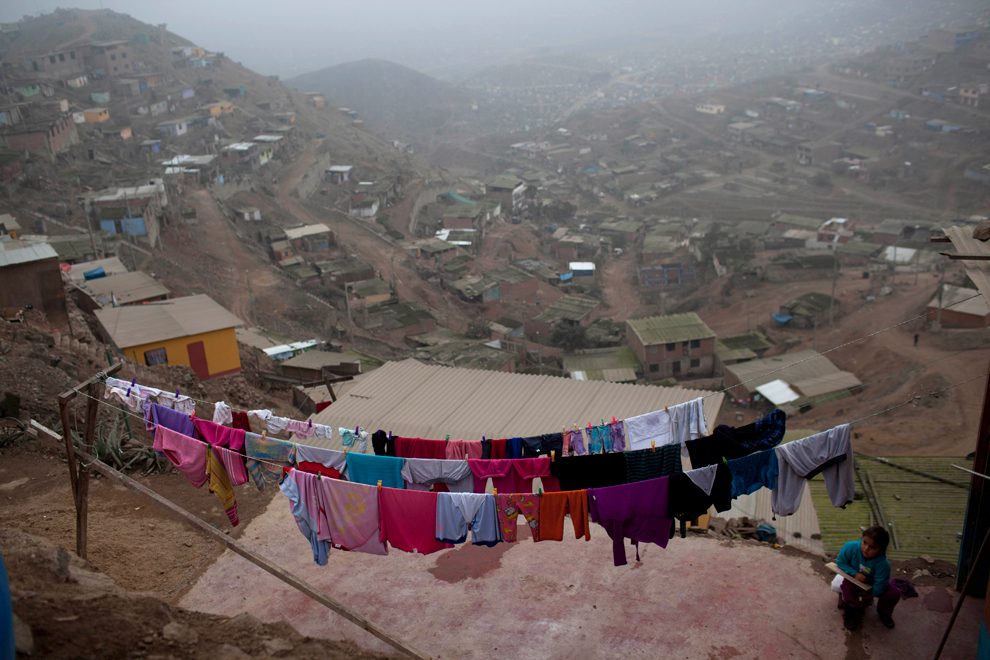
A girl sits next to clothes hanging to dry in Lima, Peru
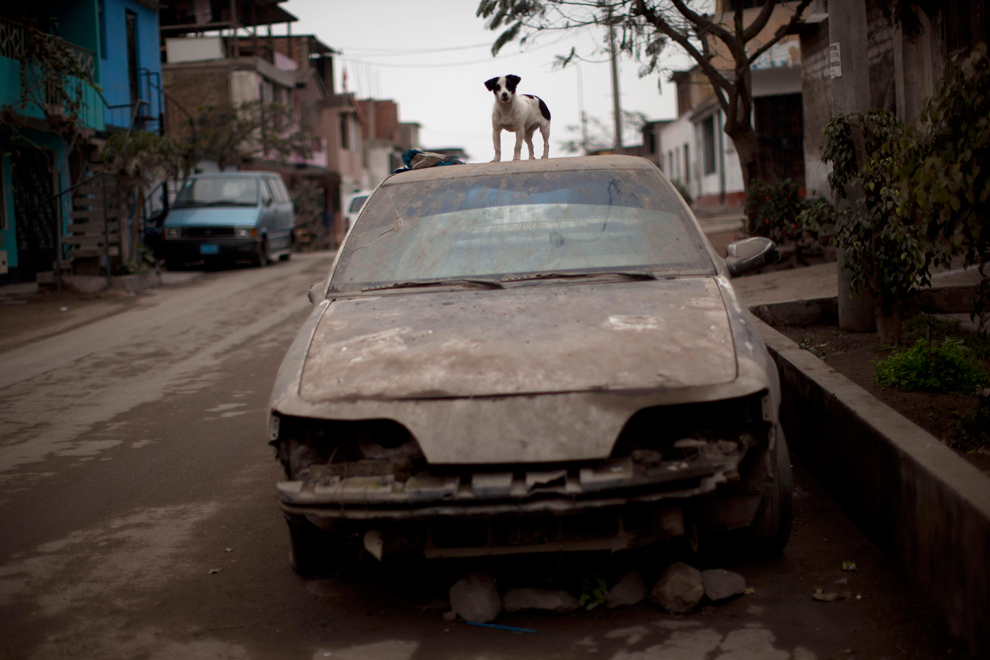
A dog stands on top of an abandoned car in the Villa Lourdes neighborhood of Lima, Peru
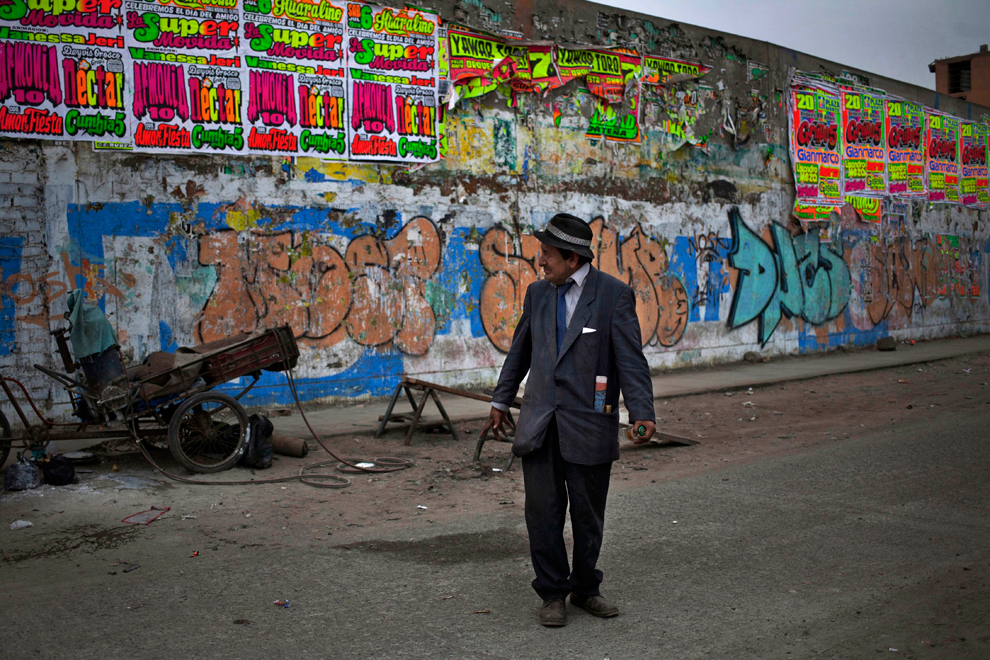
Raul Santana, 50, looks at posters on July 8 announcing Cumbia music shows in Lima, Peru
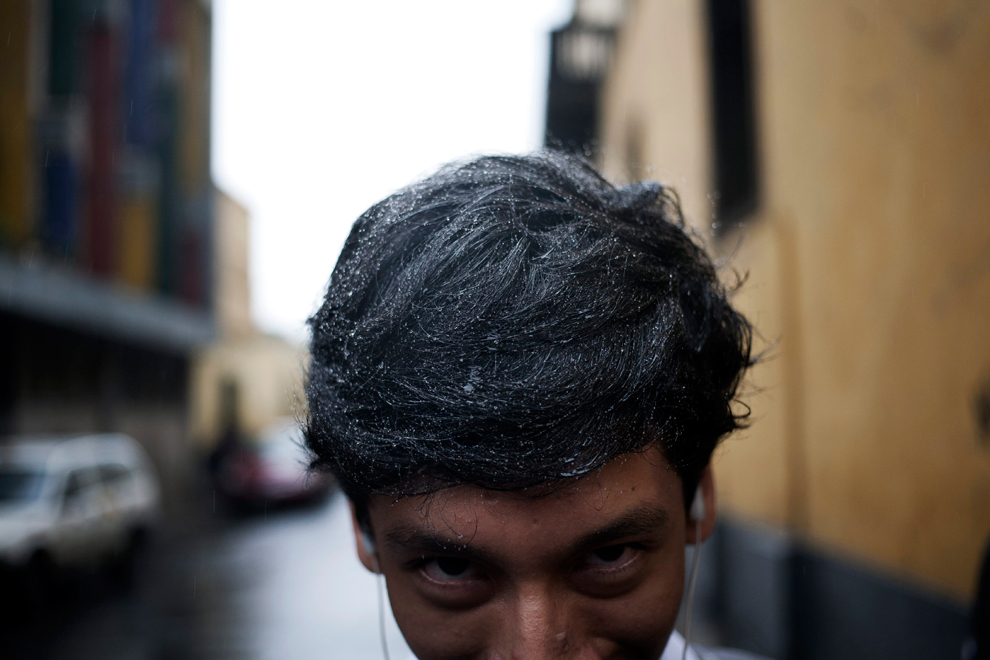
A man leans forward to show the drops of water in his hair during an intense drizzle in downtown Lima, Peru
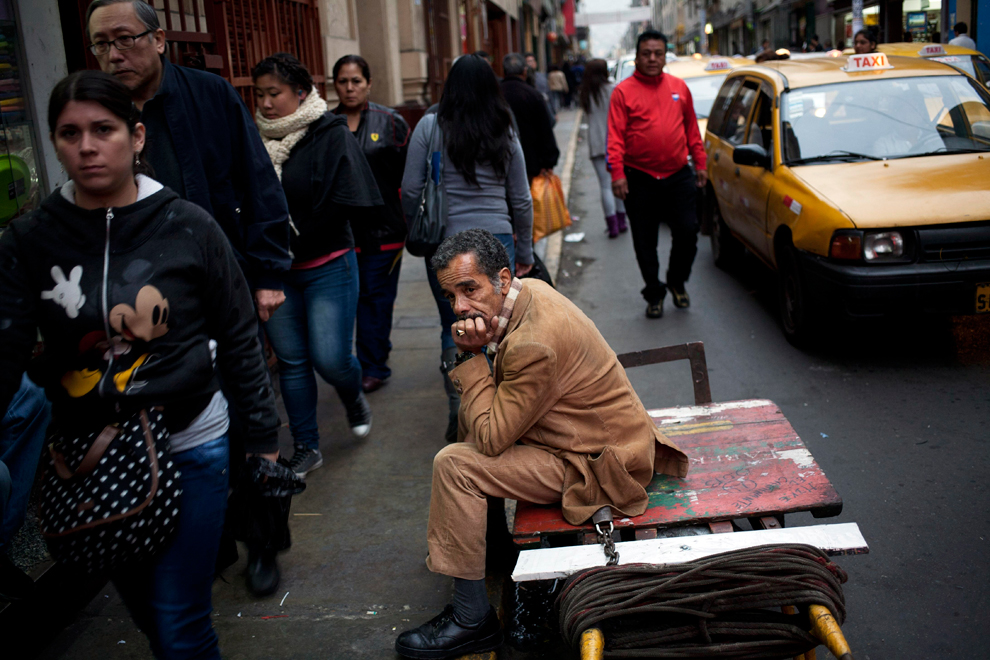
A shopkeeper takes a break in the Chinese neighborhood in Lima, Peru
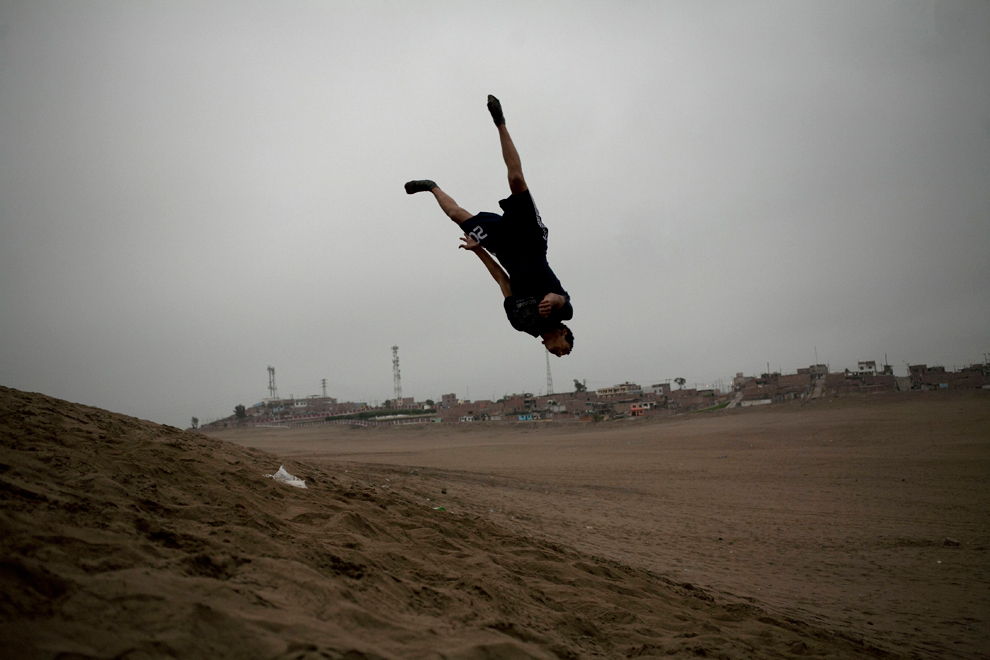
Cristian Lozada, 18, practices stunts on the sands of the Pachacamac ruins in Lima, Peru

Grey sky and a palm tree is reflected in the window of a public bus in Lima, Peru. For roughly four months a year, the sun abandons Peru's seaside desert capital, suffocating it under a ponderous gray cloud bank and fog that coats the city with nighttime drizzles. Limenos don scarfs and jackets and complain of slipping into a gloom of seasonal depression.
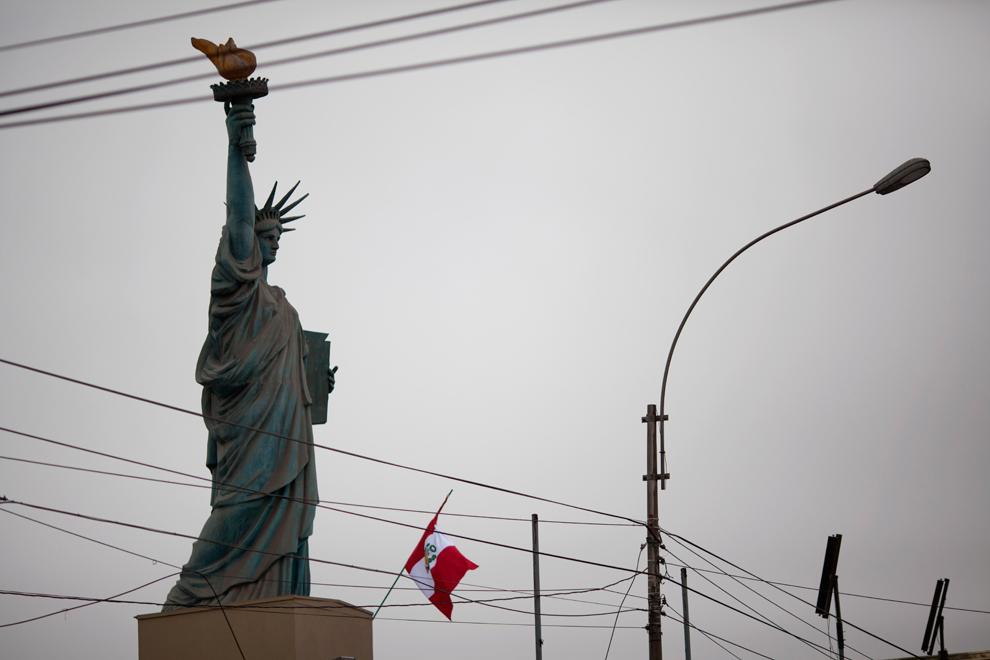
A Peruvian flag flies below a replica of the Statue of Liberty that decorates the entrance of a casino in Lima, Peru. Fines for not flying the Peruvian flag begin at about $20 and can run as high as $380, according to a 2011 study by the Peruvian Institute of Municipal Administration. Under a 1939 law, Peruvian homes, businesses and institutions are required to fly the red-and-white standard from July 27-30 to mark Independence Day, which falls on July 28.
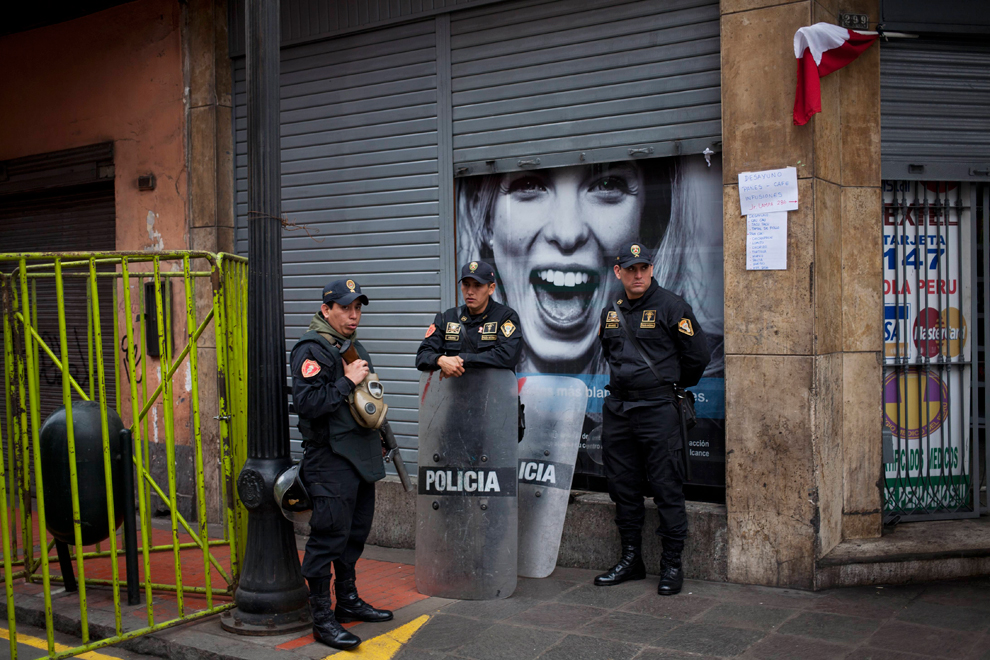
A Peruvian flag hangs tangled at the entrance of a shop where police stand guard in Lima, Peru

Clara Rojas, 68, poses for the picture with the Peruvian flag on the roof of her home in Lima, Peru


No comments:
Post a Comment
Note: Only a member of this blog may post a comment.